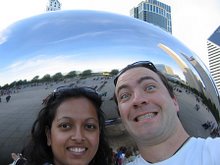As we entered the capital city, we couldn’t believe the insanity of traffic. We played a game of trying to count to five before hearing any horns and never even made it to three. In the major intersections, which are massive, hundreds of motorbikes entered from every direction without slowing down, miraculously weaved through/around dozens of others, and continued onward; a spectacle that has to be seen to be believed. We would learn later that there are about ten million motorbikes in Hanoi and that means just as many insane/incredible drivers. Also, we learned to cross the street at a slow and steady pace so that the motorcyclists could avoid us, rather than stopping and going which would cause confusion. 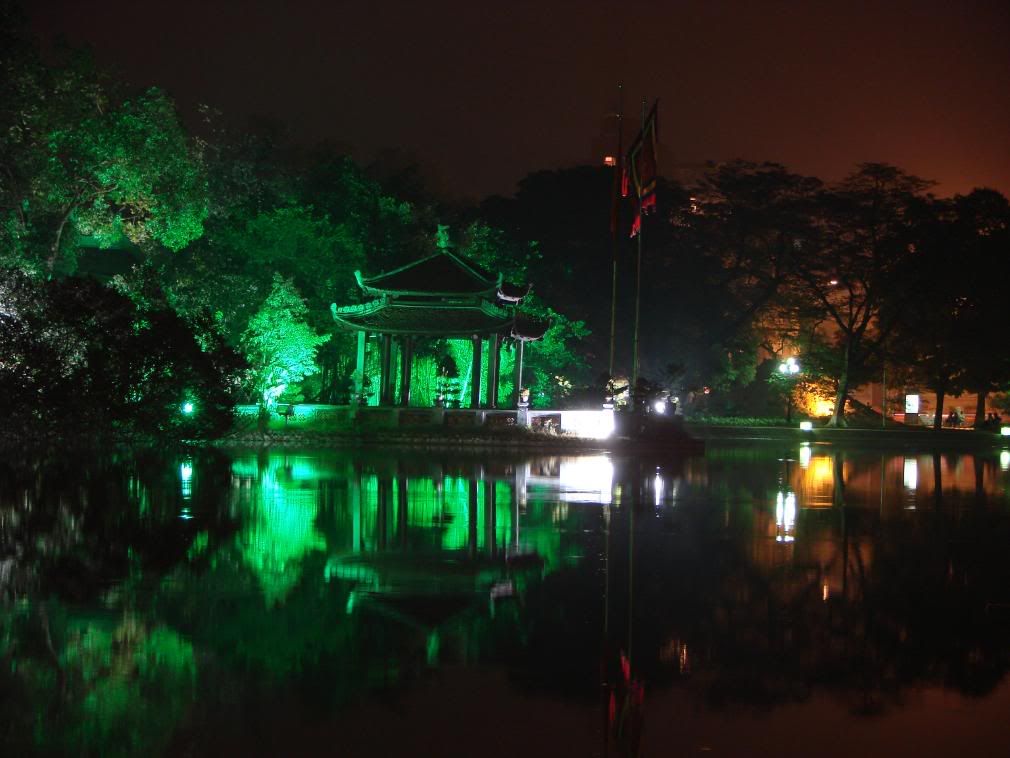 We were pretty psyched to score a nice big room with A/C, king size bed, French décor, and a balcony for $8/night. The manager asked us about taking one of the popular tours but we were too hungry to think, so we ventured out and ate at one of the countless street vendors that had many items to choose from. Feeling adventurous, we sampled frog and caterpillar larvae. As expected, the frogs tasted like chicken but were very juicy. The caterpillars tasted okay, with a crunchy outer shell and mushy inside but Jason for some reason put a huge scoop on his plate and as the meal wore on, the sight of them began to make us nauseous but nevertheless we managed to clean our plates. Then we went to a bar where a Grateful Dead cover band was playing, which brought Jason back to his days in Chicago doing the same with the Attics, although the closing time of 11 pm was much too early. When we got back to the guest house, it was chained shut, but one of the family members who was sleeping on the floor of the lobby let us in.
We were pretty psyched to score a nice big room with A/C, king size bed, French décor, and a balcony for $8/night. The manager asked us about taking one of the popular tours but we were too hungry to think, so we ventured out and ate at one of the countless street vendors that had many items to choose from. Feeling adventurous, we sampled frog and caterpillar larvae. As expected, the frogs tasted like chicken but were very juicy. The caterpillars tasted okay, with a crunchy outer shell and mushy inside but Jason for some reason put a huge scoop on his plate and as the meal wore on, the sight of them began to make us nauseous but nevertheless we managed to clean our plates. Then we went to a bar where a Grateful Dead cover band was playing, which brought Jason back to his days in Chicago doing the same with the Attics, although the closing time of 11 pm was much too early. When we got back to the guest house, it was chained shut, but one of the family members who was sleeping on the floor of the lobby let us in.
Early the next morning, we regretted taking a room with a balcony, as the incessant noise pollution started at about 6 am. We spent the next couple days sightseeing and headed first to the military museum. There were many interesting exhibits from the war, including some of the tanks and planes that had been in combat. It was an emotional roller coaster, with much sadness at the senseless tragedy of the entire war mixed with inspiration at seeing the world unite in opposition to the imperialistic U.S. government. 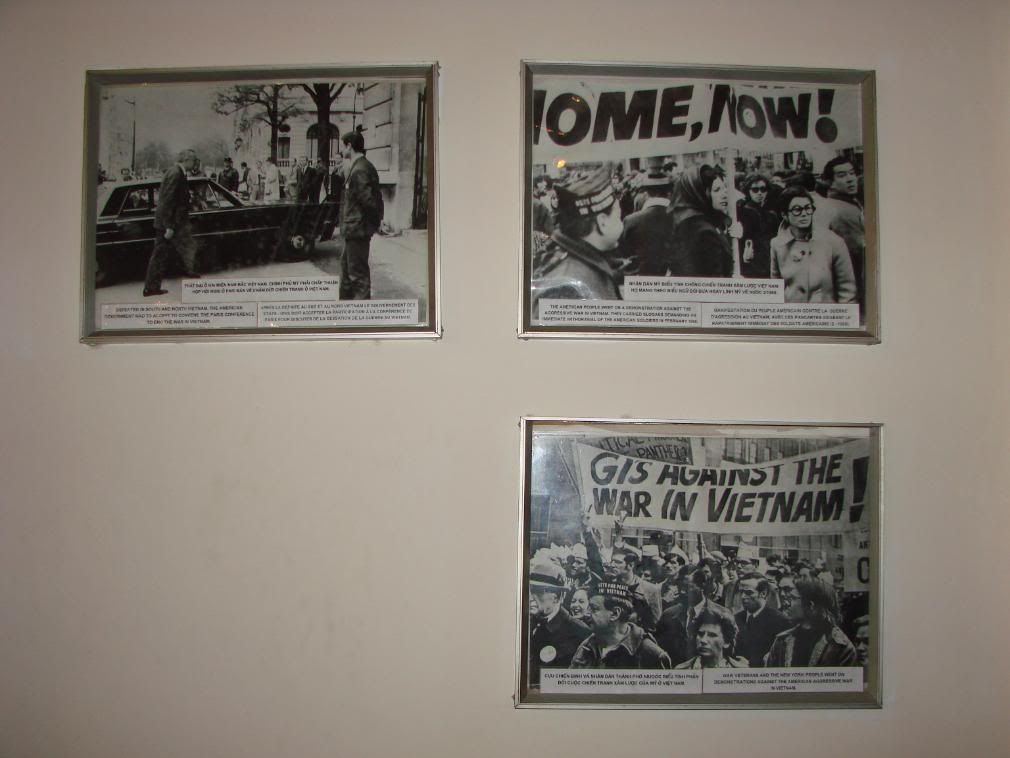 We hope that the world can once again unite in similar fashion vis a vis the Middle East before it’s too late. Our next stop was the Ho Chi Minh mausoleum, which is as big as a city block and indicative of the nation’s unquestioning devotion to their deceased revolutionary leader. His picture graces every Dong note. His name (which was a pseudonym meaning “the enlightened one”) is repeated in their national anthem, and there were as many if not more shrines devoted to him than Buddha. Yet, despite his wishes to be cremated, his body was preserved and displayed at his mausoleum, although we didn’t see it because each November his body is transported to Russia to pay homage to their shared Communist roots. Another reminder of those shared roots was Lenin Park, where there is a large statue of Ho Chi Minh’s ideological forefather.
We hope that the world can once again unite in similar fashion vis a vis the Middle East before it’s too late. Our next stop was the Ho Chi Minh mausoleum, which is as big as a city block and indicative of the nation’s unquestioning devotion to their deceased revolutionary leader. His picture graces every Dong note. His name (which was a pseudonym meaning “the enlightened one”) is repeated in their national anthem, and there were as many if not more shrines devoted to him than Buddha. Yet, despite his wishes to be cremated, his body was preserved and displayed at his mausoleum, although we didn’t see it because each November his body is transported to Russia to pay homage to their shared Communist roots. Another reminder of those shared roots was Lenin Park, where there is a large statue of Ho Chi Minh’s ideological forefather.
The next day we fortunately found a sanctuary within the chaos: the Temple of Literature. Many centuries ago, the Chinese controlled Northern Vietnam and this grand structure was a remnant of that era. Having traveled so close but not actually entering China, we have been fascinated by how strong of an influence it exerts over all of Southeast Asia. Confucian shrines were scattered throughout the grounds. 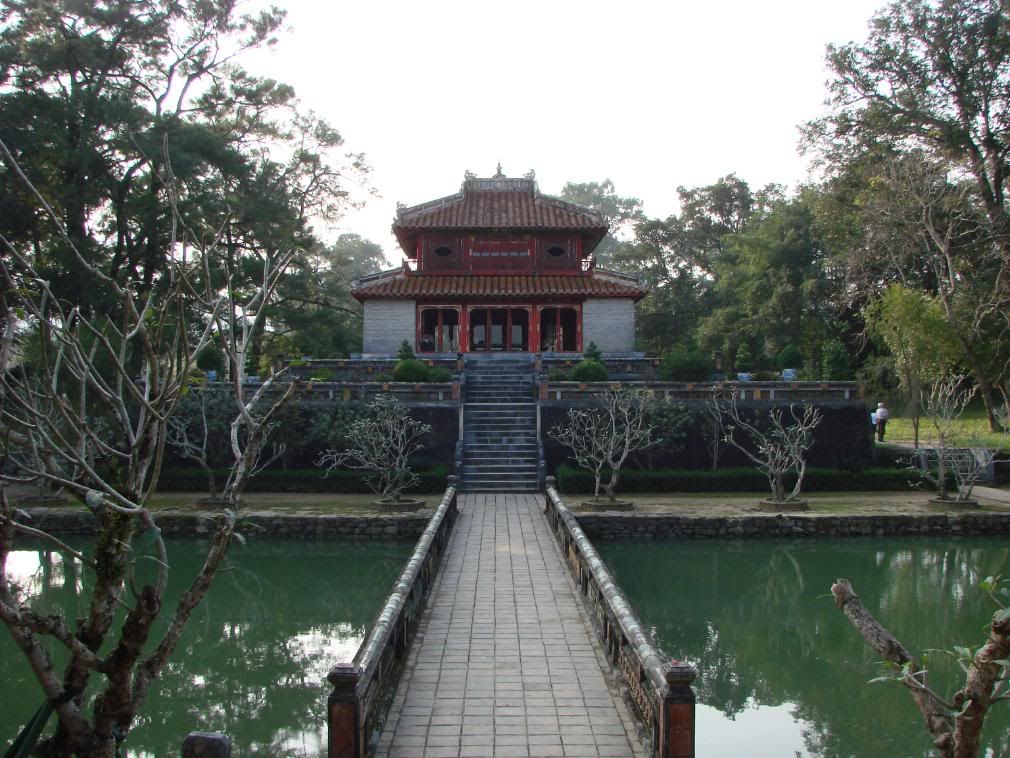 The highlight for Jason was the free traditional Vietnamese music show. (Videos will be appearing soon if they’re not already posted.) We then strolled into the adjacent park and saw many elderly folks doing calisthenics or playing badminton, while the younger crowd played a game like hacky sack, except using a cartridge-like object with a feather on the end. The lowlight of the day was when we saw an elderly woman squat and urinate on top of a pile of garbage. As dusk settled, we strolled along the picturesque lake, where every bench was occupied by a couple. After a yummy dinner of noodle soup, we set out to find a dance club on the red river. What appeared on the map to be a short jaunt turned out to be a lengthy hike and we got lost down some random alley where a nice family invited us to dinner but with bellies already full we declined. We eventually made it to the club at about 11:15, and the place was nearly empty and the music was top 40 garbage. But soon a steady stream started filing in and a good vibe was developing, when suddenly the music stopped and the manager became frantic. A few minutes later, some army officers entered and shut the place down because it was midnight. A group who had just arrived and ordered a bottle of vodka with mixers started taking shots to finish up their booze and then jet. We felt like we were in high school again, having a party broken up by the cops. While walking out, we ran into an English speaking Vietnamese woman who explained that all of Hanoi has a midnight curfew and that the only places that stay open late are fancy hotels that can afford to bribe the curfew police.
The highlight for Jason was the free traditional Vietnamese music show. (Videos will be appearing soon if they’re not already posted.) We then strolled into the adjacent park and saw many elderly folks doing calisthenics or playing badminton, while the younger crowd played a game like hacky sack, except using a cartridge-like object with a feather on the end. The lowlight of the day was when we saw an elderly woman squat and urinate on top of a pile of garbage. As dusk settled, we strolled along the picturesque lake, where every bench was occupied by a couple. After a yummy dinner of noodle soup, we set out to find a dance club on the red river. What appeared on the map to be a short jaunt turned out to be a lengthy hike and we got lost down some random alley where a nice family invited us to dinner but with bellies already full we declined. We eventually made it to the club at about 11:15, and the place was nearly empty and the music was top 40 garbage. But soon a steady stream started filing in and a good vibe was developing, when suddenly the music stopped and the manager became frantic. A few minutes later, some army officers entered and shut the place down because it was midnight. A group who had just arrived and ordered a bottle of vodka with mixers started taking shots to finish up their booze and then jet. We felt like we were in high school again, having a party broken up by the cops. While walking out, we ran into an English speaking Vietnamese woman who explained that all of Hanoi has a midnight curfew and that the only places that stay open late are fancy hotels that can afford to bribe the curfew police.
Our next adventure was a three-day tour of Halong Bay, which consists of hundreds of limestone islands scattered throughout the South China Sea. The next morning, when we checked out of our hotel, the manager unsuccessfully tried charging us 30% more because we didn’t book a tour through him. Instead, we booked directly through one of the companies that runs the tours. When we arrived at the dock, we started chatting with a couple on the same tour who were living in China (he was Chinese-American, she was Chinese). They had also been around SE Asia and were on their way back to China, and painted a very negative picture of Vietnam, saying they’d never come back because the people were abrasive, greedy and conniving. We would soon find out exactly what they meant. After getting on our boat at 11 am, we sat on the dock for two hours waiting because our guide, who was “English-speaking” per the tour agency, couldn’t speak more than a few words of English and had no idea what was going on. We speculated that they were trying to get last minute people on board, none of whom materialized. After eating an ok lunch, we were taken to the largest and most impressive cave we’ve ever seen, which was lit up with varying colors.  Because our guide was frantically running around trying to figure out who among our tour had tickets for the caves (we all should have but apparently some did not), we tagged along with another English speaking tour guide. After the caves, we docked on an island to pick up more passengers. Although we were supposed to sleep on the boat the first night, since they’d overbooked, we were going to a hotel. So we sat at the dock for another hour, waiting to be transported to the hotel by a new “English speaking guide” (the first one had supposedly been fired and sent back). A drunk obnoxious German guy who got on the boat started yelling about his passport and put us all on edge when he acted as if it had been lost (which it hadn’t). Nonetheless, they managed to drop another woman’s passport into the water. After they finally straightened out who was going where, we waved farewell to the Chinese couple, whose Vietnam nightmare culminated that night on the boat we should have been on (but first our story).
Because our guide was frantically running around trying to figure out who among our tour had tickets for the caves (we all should have but apparently some did not), we tagged along with another English speaking tour guide. After the caves, we docked on an island to pick up more passengers. Although we were supposed to sleep on the boat the first night, since they’d overbooked, we were going to a hotel. So we sat at the dock for another hour, waiting to be transported to the hotel by a new “English speaking guide” (the first one had supposedly been fired and sent back). A drunk obnoxious German guy who got on the boat started yelling about his passport and put us all on edge when he acted as if it had been lost (which it hadn’t). Nonetheless, they managed to drop another woman’s passport into the water. After they finally straightened out who was going where, we waved farewell to the Chinese couple, whose Vietnam nightmare culminated that night on the boat we should have been on (but first our story).
When we packed in to the van, there was not enough room, because a French couple had been scammed and their receipt didn’t have transport to the hotel listed. There was another bus but after woman yelled at several people, the other driver refused to take her and closed the bus door in her face. Rather than pay the $5 it would’ve cost her to get a motocab (i.e., riding on the back of a motorcycle), she started bawling and screamed at the rest of us in the van, “I can’t believe you guys are just gonna leave us here like this!” 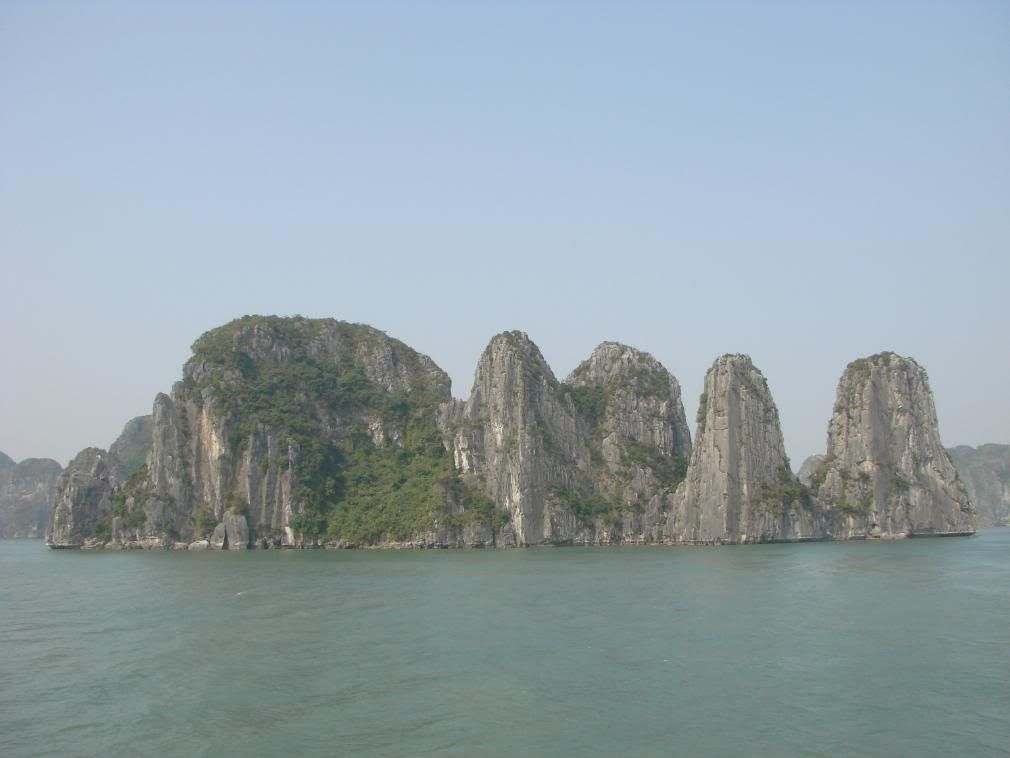 Jason was laughing at her, but some other French tourists took pity and we managed to squeeze them in at our expense, as both of us had to endure the hour long journey across the island with huge bags on our laps and in our leg space. We never determined why the boat didn’t just dock on the other side of the island where the hotels were located. Upon arriving at the hotel, we discovered that it was well outside of the town (and its beach) and we were the only ones staying there. All of us were pretty agitated by this point, and then the guide explained that the next afternoon we were on our own, even though there was nothing for us to do. When we booked the tour, we had actually paid extra to have an afternoon of kayaking, but it took us almost two hours to get the guide to agree that we would get what we’d paid for. Ironically, the guide was in school studying “tourism” and the group had fun speculating what the curriculum entailed: misrepresenting tours, counting money, and deflecting responsibility seemed to cover it. But, after things cooled down, we had fun learning some Vietnamese, such as the four different meanings of Ba—grandfather, uncle, mosquito, or disgusting—depending on how it was said (like Chinese, Vietnamese is a tonal language). We also learned how to say “I love you” to each other (Ang You Am/Am You Ang), which generated lots of laughs throughout the rest of our stay.
Jason was laughing at her, but some other French tourists took pity and we managed to squeeze them in at our expense, as both of us had to endure the hour long journey across the island with huge bags on our laps and in our leg space. We never determined why the boat didn’t just dock on the other side of the island where the hotels were located. Upon arriving at the hotel, we discovered that it was well outside of the town (and its beach) and we were the only ones staying there. All of us were pretty agitated by this point, and then the guide explained that the next afternoon we were on our own, even though there was nothing for us to do. When we booked the tour, we had actually paid extra to have an afternoon of kayaking, but it took us almost two hours to get the guide to agree that we would get what we’d paid for. Ironically, the guide was in school studying “tourism” and the group had fun speculating what the curriculum entailed: misrepresenting tours, counting money, and deflecting responsibility seemed to cover it. But, after things cooled down, we had fun learning some Vietnamese, such as the four different meanings of Ba—grandfather, uncle, mosquito, or disgusting—depending on how it was said (like Chinese, Vietnamese is a tonal language). We also learned how to say “I love you” to each other (Ang You Am/Am You Ang), which generated lots of laughs throughout the rest of our stay.
The next morning, our room had no hot water (despite several claims to the contrary) and we were sent on a pretty strenuous hike where the “English speaking guide” said nothing the entire time. Jason, perhaps subconsciously willing us to the beach, only wore flip-flops and found that they actually provide good traction because they allowed his feet to grip the terrain. 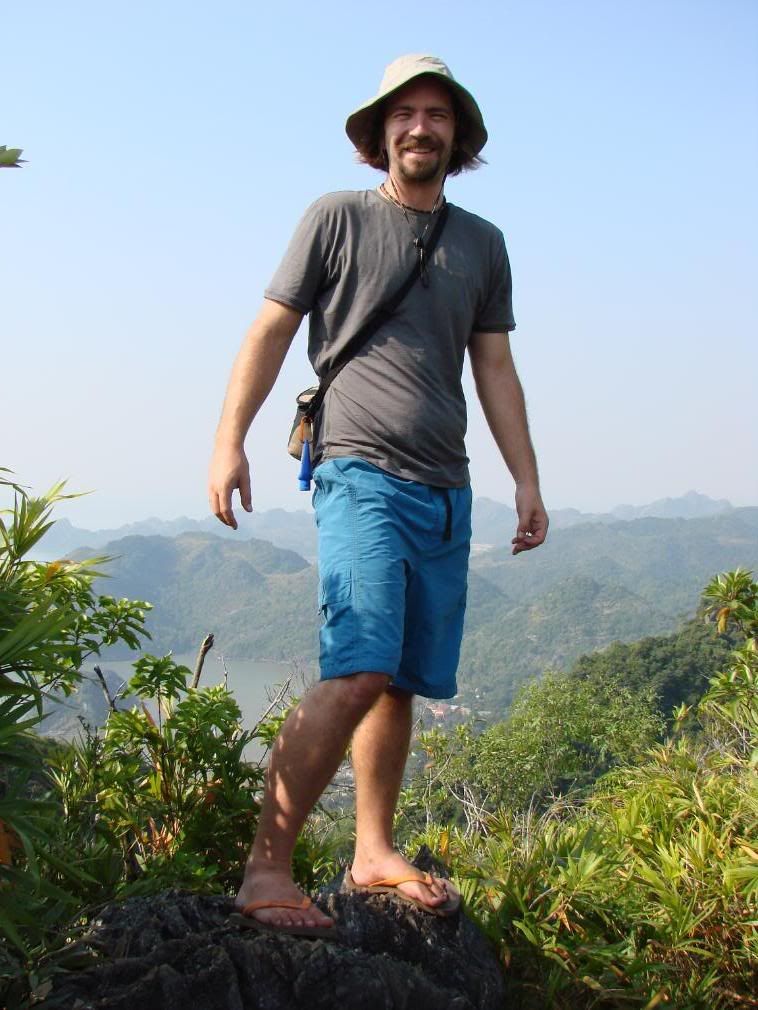 On the flip side, they offer little protection and a jagged rock punctured one of them, but fortunately not his foot although it felt like it had. After the hike and after overcoming another stream of objections from the guide about providing kayaks, we went kayaking around some of the islands. The water was disgusting, but the scenery was very similar to El Nido, Philippines so we had a nice afternoon. Then it was back in the van to transfer back to the boat. Incredibly, they didn’t know the tide schedule so we had to wait yet again over an hour because the tide was too low for the boats to dock. This meant we would not be able to kayak in the evening to see the tunnels and caves, which was also promised by the tour agency. To make up for it, we were told we’d be able to see go kayaking the following morning. When we finally got on the boat, we were pleasantly surprised to see the condition of our room which even had its own bathroom with a shower head that wasn’t enclosed! The water in the shower did not drain because the bathroom floor wasn’t slanted enough; so we made sure to sweep the water down so that our room would not flood. After returning to our bedroom following another mediocre dinner, Jason heard a chorus of rats squealing in the walls. Knowing Priti’s fear and loathing of them, when she inquired about the noise, he tried to play it off by telling her “it’s just the wind,” although it didn’t take long for her to figure out we weren’t alone in the room. She did not sleep much, out of fear that one of them would possibly crawl into her bed.
On the flip side, they offer little protection and a jagged rock punctured one of them, but fortunately not his foot although it felt like it had. After the hike and after overcoming another stream of objections from the guide about providing kayaks, we went kayaking around some of the islands. The water was disgusting, but the scenery was very similar to El Nido, Philippines so we had a nice afternoon. Then it was back in the van to transfer back to the boat. Incredibly, they didn’t know the tide schedule so we had to wait yet again over an hour because the tide was too low for the boats to dock. This meant we would not be able to kayak in the evening to see the tunnels and caves, which was also promised by the tour agency. To make up for it, we were told we’d be able to see go kayaking the following morning. When we finally got on the boat, we were pleasantly surprised to see the condition of our room which even had its own bathroom with a shower head that wasn’t enclosed! The water in the shower did not drain because the bathroom floor wasn’t slanted enough; so we made sure to sweep the water down so that our room would not flood. After returning to our bedroom following another mediocre dinner, Jason heard a chorus of rats squealing in the walls. Knowing Priti’s fear and loathing of them, when she inquired about the noise, he tried to play it off by telling her “it’s just the wind,” although it didn’t take long for her to figure out we weren’t alone in the room. She did not sleep much, out of fear that one of them would possibly crawl into her bed.
Our tour from hell kept right on rolling as we were awoken at 6 am the following morning to a flooded room. We’re not sure where the water came from, but it ended up covering our bags, though thankfully nothing was ruined. We made our way out to the dock as others were pushing off on fiberglass kayaks. We observed that three of the kayaks were flipped over and had significant holes in the bottoms. 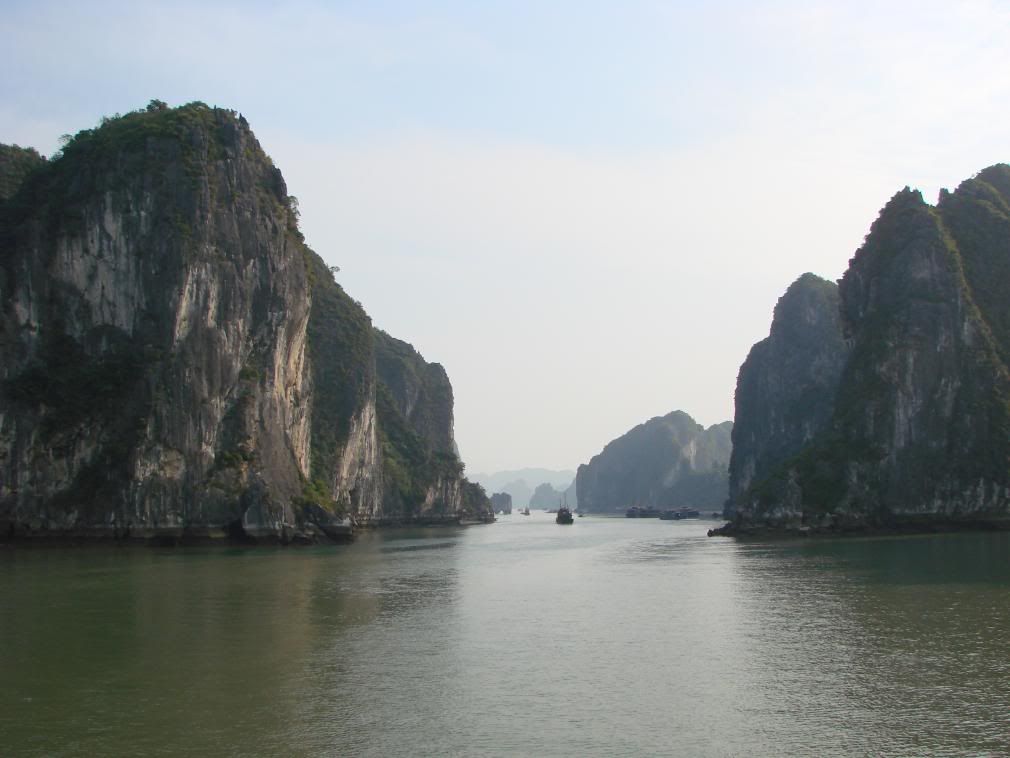 As other travelers pushed away in pairs, a quick count revealed that there weren’t enough functioning kayaks for everyone, and of course we were in the back of the line. At this point, Jason became very un-dude as he yelled at them for five minutes (“sorry this, sorry that, it means nothing man!”). Back on the boat, we watched in a mixture of bemusement, incredulity, and RAGE as one of the workers used some epoxy to stick on a handful of fiberglass shreds to “fix” one of the kayaks and then told us, “it’s okay now, you can go.” We obviously chose not to risk it.
As other travelers pushed away in pairs, a quick count revealed that there weren’t enough functioning kayaks for everyone, and of course we were in the back of the line. At this point, Jason became very un-dude as he yelled at them for five minutes (“sorry this, sorry that, it means nothing man!”). Back on the boat, we watched in a mixture of bemusement, incredulity, and RAGE as one of the workers used some epoxy to stick on a handful of fiberglass shreds to “fix” one of the kayaks and then told us, “it’s okay now, you can go.” We obviously chose not to risk it.
The final transfer (which is all this “tour” really was, a series of transfers like a ferry boat) took us to a restaurant back on shore, at which we waited an hour for the rest of the tour groups to arrive before being served another mediocre meal. We decided, along with some Swiss women, who had been completely ripped off and paid twice as much as anyone else, to air our grievances with the tour operator back in Hanoi. After telling the woman who booked us the tour our horrible experiences, she smiled and said that everything was okay since we got to go kayaking; after calling her boss she agreed to refund us $3! When Jason finally got the boss on the phone, she just kept repeating “hello, hello” and feigned incomprehension. We begrudgingly accepted her final offer of $5 (since it was not about the money) but refused to sign off that we had received the refund, thereby pitting the agent against her boss (who was supposedly going to take it out of the agent’s pay). That is how angry we were. The Swiss women were told to take their complaints to the head office down the street; when we arrived in solidarity (again, that angry) there was no one in the office. None of us were surprised. We must apologize as this was undoubtedly painful to read, but trust us it was more painful to live it and then write about it.
After telling the woman who booked us the tour our horrible experiences, she smiled and said that everything was okay since we got to go kayaking; after calling her boss she agreed to refund us $3! When Jason finally got the boss on the phone, she just kept repeating “hello, hello” and feigned incomprehension. We begrudgingly accepted her final offer of $5 (since it was not about the money) but refused to sign off that we had received the refund, thereby pitting the agent against her boss (who was supposedly going to take it out of the agent’s pay). That is how angry we were. The Swiss women were told to take their complaints to the head office down the street; when we arrived in solidarity (again, that angry) there was no one in the office. None of us were surprised. We must apologize as this was undoubtedly painful to read, but trust us it was more painful to live it and then write about it.
The next day in Ninh Binh, a couple hours south of Hanoi, was a complete reversal of our misfortunes. We rented bicycles and went to a river where the scenery was very similar to Halong Bay, with huge limestone rocks on both shores of the river.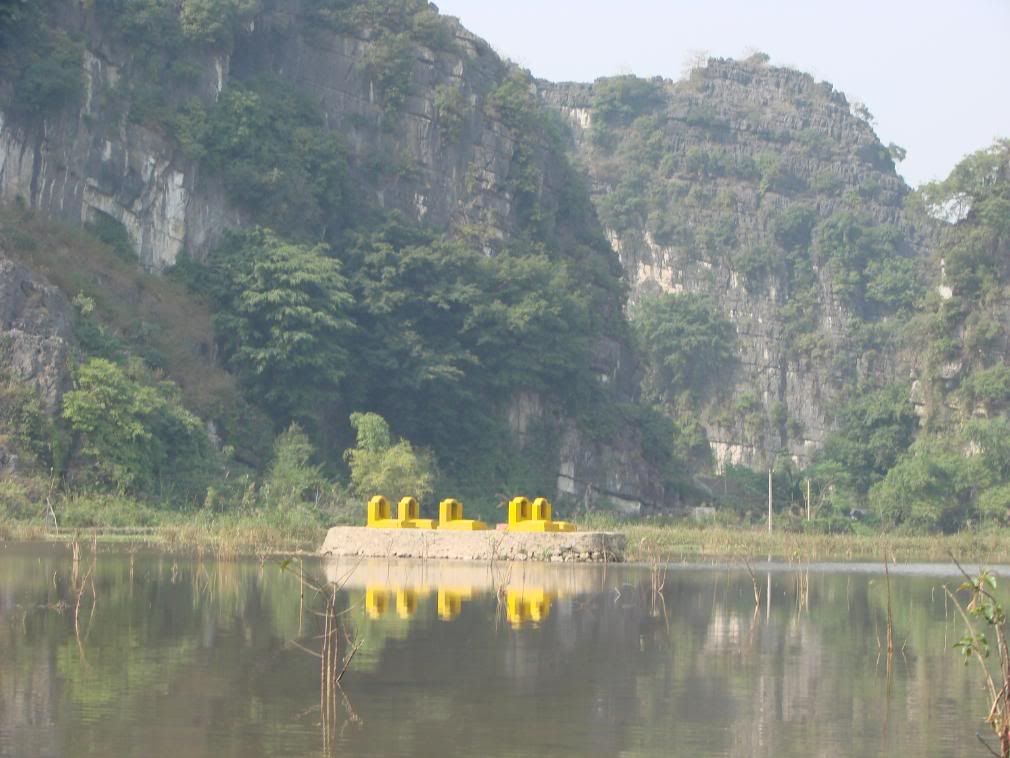 We avoided the area where there were hundreds of tourist boats and found another boat-woman to take us on her paddle boat. For the entire two hours, as she paddled with her feet, we didn’t see another boat and she took us to her local pagoda which was built right into one of the limestone rocks. We also saw tombstones jutting out of the river. Of course, she screwed us out of change but we didn’t mind since the tour was good.
We avoided the area where there were hundreds of tourist boats and found another boat-woman to take us on her paddle boat. For the entire two hours, as she paddled with her feet, we didn’t see another boat and she took us to her local pagoda which was built right into one of the limestone rocks. We also saw tombstones jutting out of the river. Of course, she screwed us out of change but we didn’t mind since the tour was good. 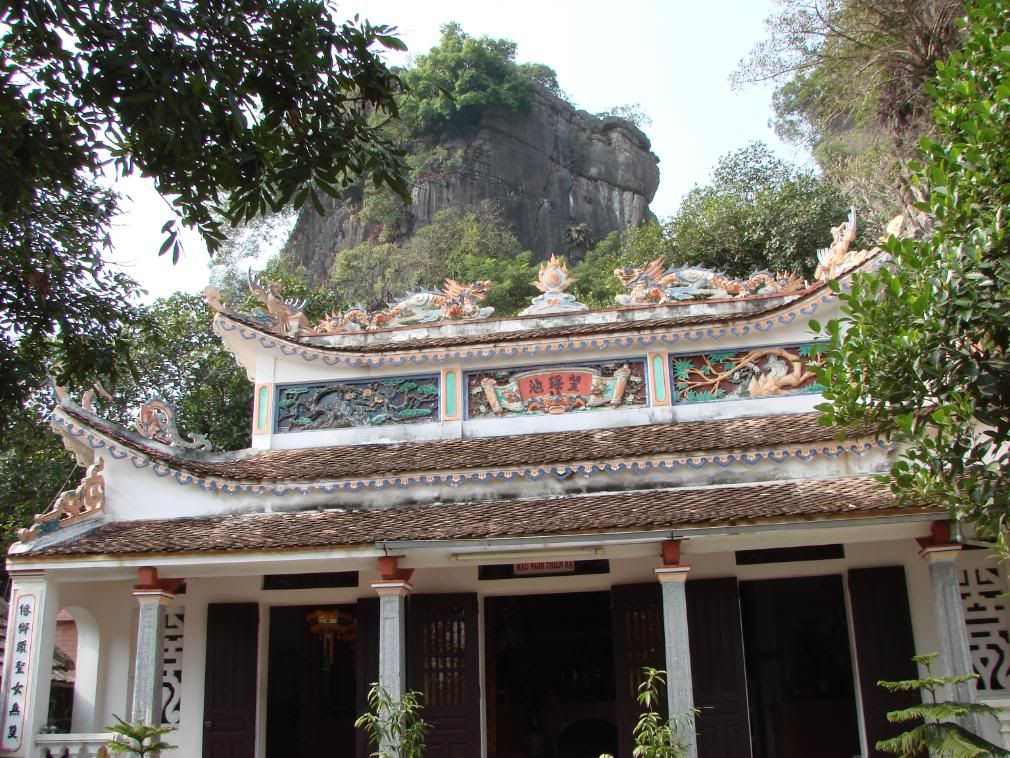 Afterward, we kept riding our bikes and found some more pagodas and caves. Even further, we bumped into some local children who hopped on the backs of our bikes and hung out with us for an hour (though it seemed like more). We met their mother and had fun trying to communicate with no common linguistics. One of the children disappointingly made a grab at Jason’s pocket but was immediately scolded by his mother.
Afterward, we kept riding our bikes and found some more pagodas and caves. Even further, we bumped into some local children who hopped on the backs of our bikes and hung out with us for an hour (though it seemed like more). We met their mother and had fun trying to communicate with no common linguistics. One of the children disappointingly made a grab at Jason’s pocket but was immediately scolded by his mother.
Being kind of pressed for time (or so we thought), we left the following night on an overnight sleeper bus to Hue, which is famous for being ransacked by the North Vietnamese army in their final thrust to defeat the U.S.A. When we got on the bus, there was only one sleeper bed spot open, so one poor guy (who we suspect hadn’t bought a ticket) had to sleep on the floor.  Perhaps he slept, because we sure didn’t for more than a few minutes at time, due to the reckless driving and road conditions. For example, Jason awoke several times airborne after the bus had hit a bump. But at least he was in the far back, where the beds were flat, albeit too short for Jason. Priti’s bed, on the other hand, had a metal hump under her back, slanted to make room for the feet of the person behind her. In addition, the intoxicated person above her dropped her blanket several times, requesting Priti retrieve for her. After a few times, Priti feigned being asleep.
Perhaps he slept, because we sure didn’t for more than a few minutes at time, due to the reckless driving and road conditions. For example, Jason awoke several times airborne after the bus had hit a bump. But at least he was in the far back, where the beds were flat, albeit too short for Jason. Priti’s bed, on the other hand, had a metal hump under her back, slanted to make room for the feet of the person behind her. In addition, the intoxicated person above her dropped her blanket several times, requesting Priti retrieve for her. After a few times, Priti feigned being asleep.
Hue was not very exciting and we left the next day for Hoi An, a charming city with a flourishing art scene and where many foreigners go to get inexpensive tailored clothes. Hand-tailored wool suits run about $40 while custom-made suede shoes can be had for $20. Jason, who is like a woman when it comes to shoes, almost succumbed but thought better since he had no room in his luggage for them. We heard stories of people getting ripped off and getting ill-fitting suits, but only when they paid beforehand. Caveat emptor! We explored the market and saw all kinds of interesting seafood. 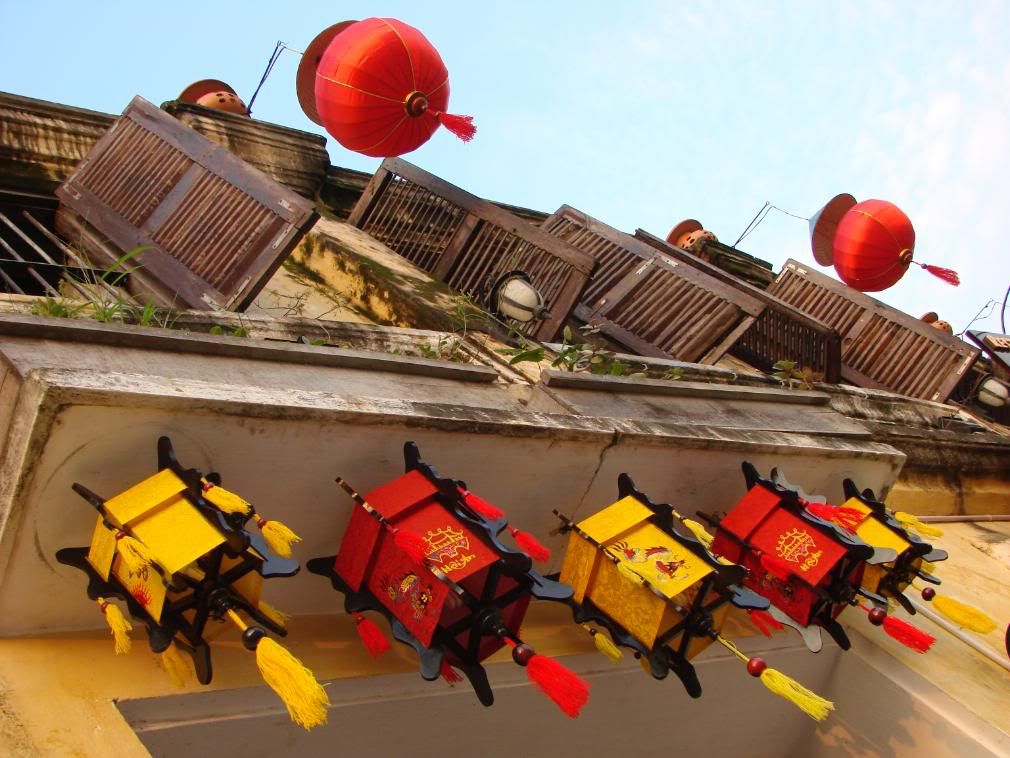 We ended up tasting some of it that night with a five-course meal that ended with mouth-watering string-ray. Jason spent the following day at the beach while Priti went shopping at the market. The beach was somewhat relaxing, although Jason had to ignore the constant harassment from the beach vendors and stay vigilant every time he went in the water. That evening, we met up with Duong, a member of the Danang Easy Riders, who offer motorbike tours of the central highlands. Duong had a number of nicknames, including Uncle #9 since he was the ninth child of his father, who had four wives in different cities. He showed us a notebook full of positive feedback from previous customers and we agreed on a five-day trip to Dalat. Although the cost was steep by Vietnam standards ($110 per day for both of us), we naively figured that we could bypass the constant harassment by getting out of the standard tourist loop (i.e., down the coast). We were ready to put the past behind us and see the real Vietnam!
We ended up tasting some of it that night with a five-course meal that ended with mouth-watering string-ray. Jason spent the following day at the beach while Priti went shopping at the market. The beach was somewhat relaxing, although Jason had to ignore the constant harassment from the beach vendors and stay vigilant every time he went in the water. That evening, we met up with Duong, a member of the Danang Easy Riders, who offer motorbike tours of the central highlands. Duong had a number of nicknames, including Uncle #9 since he was the ninth child of his father, who had four wives in different cities. He showed us a notebook full of positive feedback from previous customers and we agreed on a five-day trip to Dalat. Although the cost was steep by Vietnam standards ($110 per day for both of us), we naively figured that we could bypass the constant harassment by getting out of the standard tourist loop (i.e., down the coast). We were ready to put the past behind us and see the real Vietnam!
After securing our bags to the backs of the bikes, we set off into the countryside. The tour started off well enough, and our first stop was a local village where we got to try our hands at making pottery on a manual foot-spun wheel. 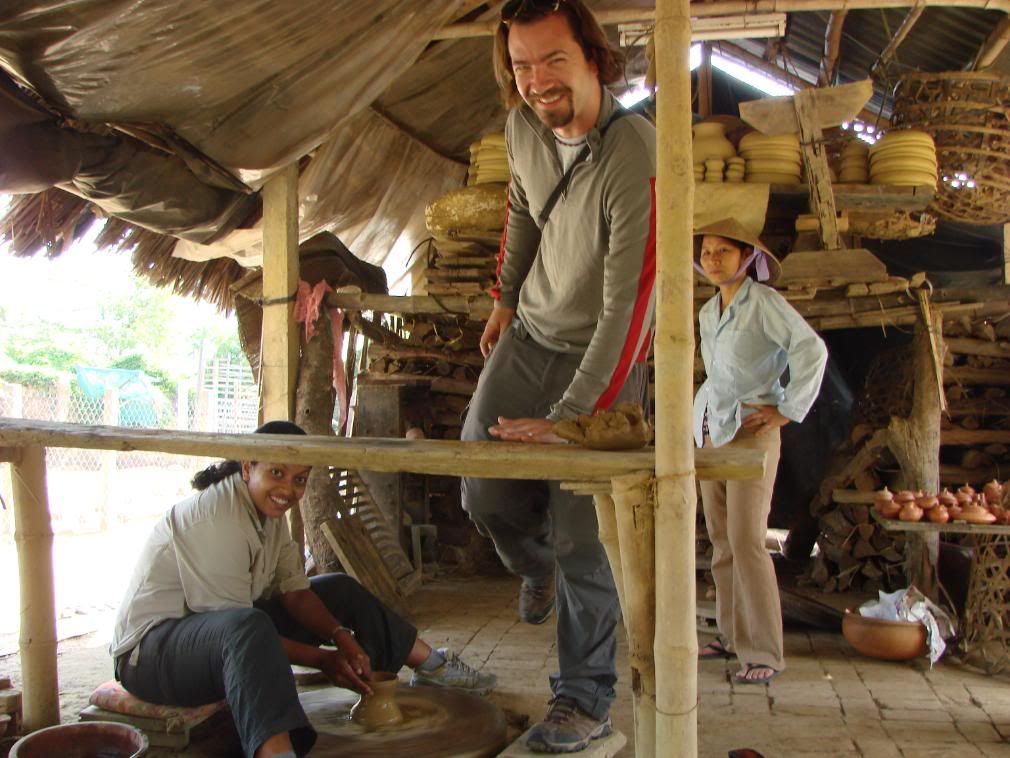 Duong and Hong then dropped us off at ancient Cham ruins in My Son. The Cham people are Hindus who centuries back controlled a good portion of central Vietnam, Laos, and Cambodia. Unfortunately for them, they were divided and conquered and now only scattered villages remain of the once mighty empire. As with most ancient sites in SE Asia, the heads were removed from most of the statues. We also got to see a traditional dance show full of beautiful dancers with incredible control of their bodies. We stopped for lunch and the first crack appeared when we ended up paying the entire lunch bill, which was not part of our agreement with the Easy Riders. That afternoon, we passed through another village where we witnessed how noodles and rice wine were made.
Duong and Hong then dropped us off at ancient Cham ruins in My Son. The Cham people are Hindus who centuries back controlled a good portion of central Vietnam, Laos, and Cambodia. Unfortunately for them, they were divided and conquered and now only scattered villages remain of the once mighty empire. As with most ancient sites in SE Asia, the heads were removed from most of the statues. We also got to see a traditional dance show full of beautiful dancers with incredible control of their bodies. We stopped for lunch and the first crack appeared when we ended up paying the entire lunch bill, which was not part of our agreement with the Easy Riders. That afternoon, we passed through another village where we witnessed how noodles and rice wine were made. 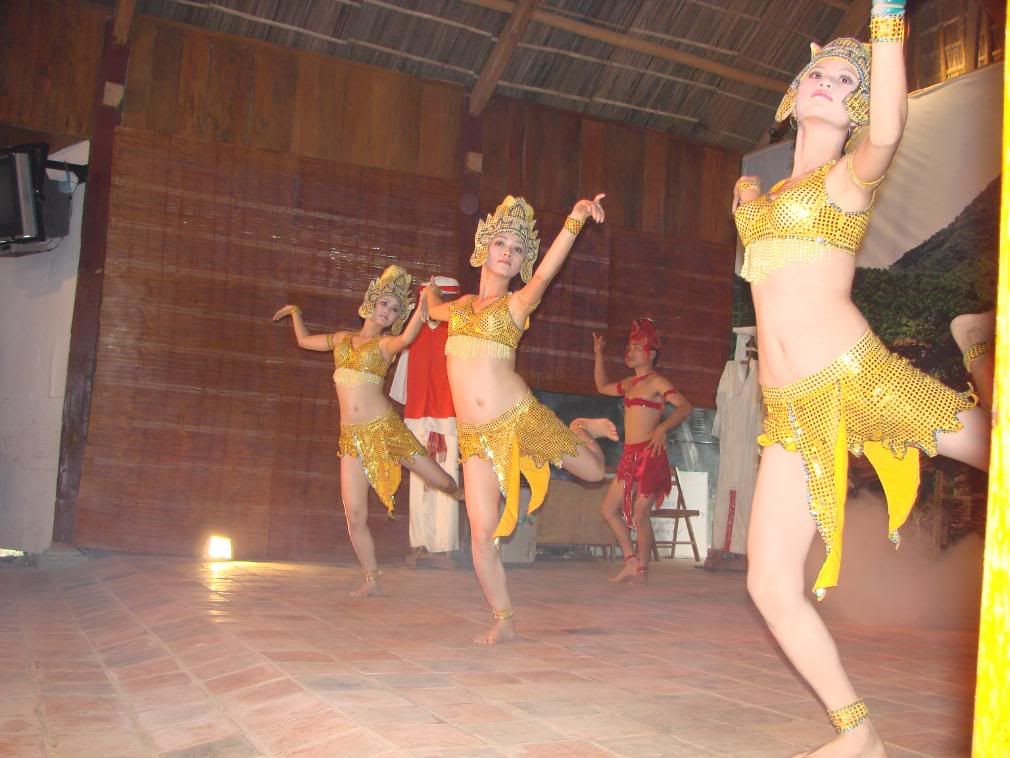 We also stopped at a waterfall adjacent to the Ho Chi Minh trail. When we arrived at our first guest house, we were pretty annoyed because it was a total dump and we’d been told our accommodations would be nice. When the bill arrived after dinner, which consisted of a series of dishes highlighted with a scrumptious tuna steak, we had to remind them that we were not covering their meals and alcohol. Jason also tried the “happy water,” as they called the local rice wine, but since we were both pretty tired, we headed to bed fairly early.
We also stopped at a waterfall adjacent to the Ho Chi Minh trail. When we arrived at our first guest house, we were pretty annoyed because it was a total dump and we’d been told our accommodations would be nice. When the bill arrived after dinner, which consisted of a series of dishes highlighted with a scrumptious tuna steak, we had to remind them that we were not covering their meals and alcohol. Jason also tried the “happy water,” as they called the local rice wine, but since we were both pretty tired, we headed to bed fairly early.
The next morning we were annoyed but not surprised that our room did not have hot water. When we expressed our displeasure with our room, our guides assured us the next guest house would be much nicer. The weather looked ominous and sure enough it began to rain as we ascended into a mountain range. The scenery was gorgeous and their rain gear kept us dry, although the bitter cold was quickly becoming a major obstacle to enjoying the ride. Thankfully the rain and cold dissipated as we descended back down the other side of the mountains and soon we were removing most of the layers we’d piled on that morning. We stopped at a coffee plantation where one of the workers was smoking tobacco from what appeared to be a bong. He generously offered Jason a sample of his smoke and it was the strongest tobacco he’d ever had; the next hour flew right by. We continued on to another village that was extremely poor, yet incredibly one of the hovels had a satellite dish attached. Our final stop was a local orphanage that was filled with children who had been abandoned by village teens not yet ready or willing for parenthood. We brought lots of candies although Kleenex would have been more appropriate, since most of the kids had runny noses and dirty (and quickly sticky) hands. It was sad seeing so many orphans but most of them seemed like pretty good kids, and whenever we picked them up they did not want to be put back down. Priti joined some of the girls in a game of Chinese jumprope, a game reminiscent of her own childhood. 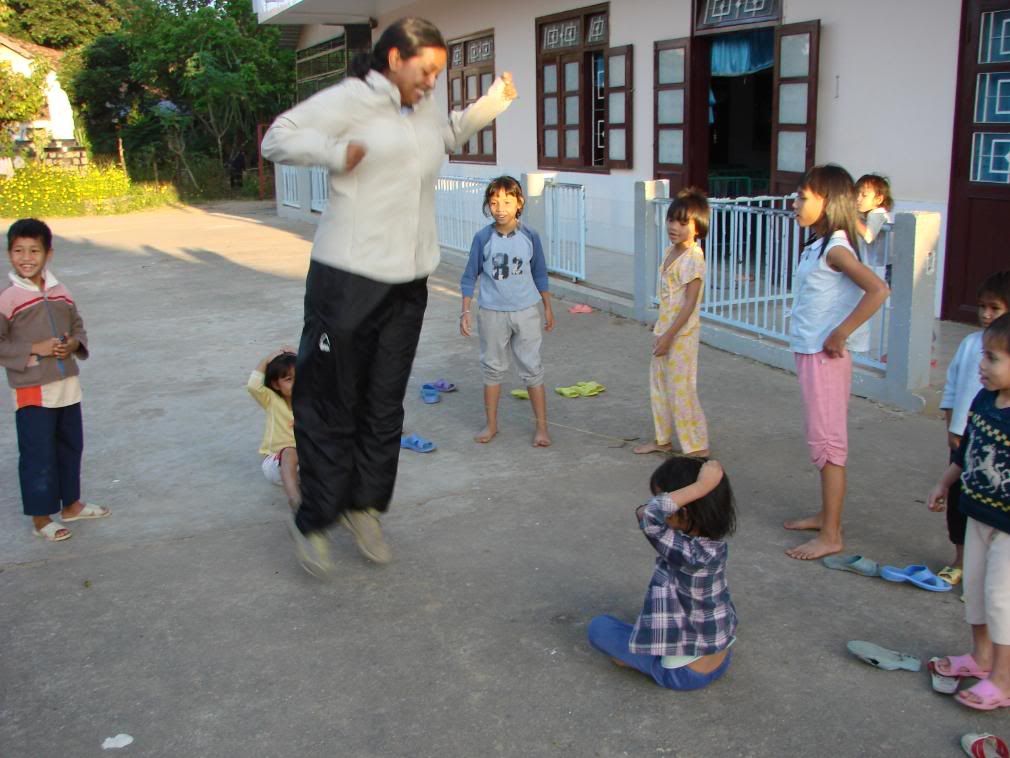 That evening, we were taken to a very nice guest house as well as a splendid restaurant. Duong shared some hilarious stories about the villagers who were notoriously bad about using birth control, despite repeated attempts to educate them. One pubescent couple, who procreated shortly after finishing one of the classes, explained that the boy had put the jacket on his thumb each time, just like they’d seen in the class! Another one explained that the jacket was too long so he cut off the end. Priti was particularly amused considering she had taught safe-sex education classes for the American Red Cross. Duong also made what would turn out to be an interesting comment about how he had on occasion ended tours early when he didn’t like his traveling companions.
That evening, we were taken to a very nice guest house as well as a splendid restaurant. Duong shared some hilarious stories about the villagers who were notoriously bad about using birth control, despite repeated attempts to educate them. One pubescent couple, who procreated shortly after finishing one of the classes, explained that the boy had put the jacket on his thumb each time, just like they’d seen in the class! Another one explained that the jacket was too long so he cut off the end. Priti was particularly amused considering she had taught safe-sex education classes for the American Red Cross. Duong also made what would turn out to be an interesting comment about how he had on occasion ended tours early when he didn’t like his traveling companions.
The next morning, after refreshing hot showers, we enjoyed a relaxing breakfast in a beautiful garden attached to our guesthouse; the calm before the storm. Hong informed us that Duong’s father had passed away that night and he had to return to his family. But, he assured us, he had contacted another Easy Rider to take his place. We momentarily considered our options, but figured the Easy Riders were a reputable group and it would be ok. 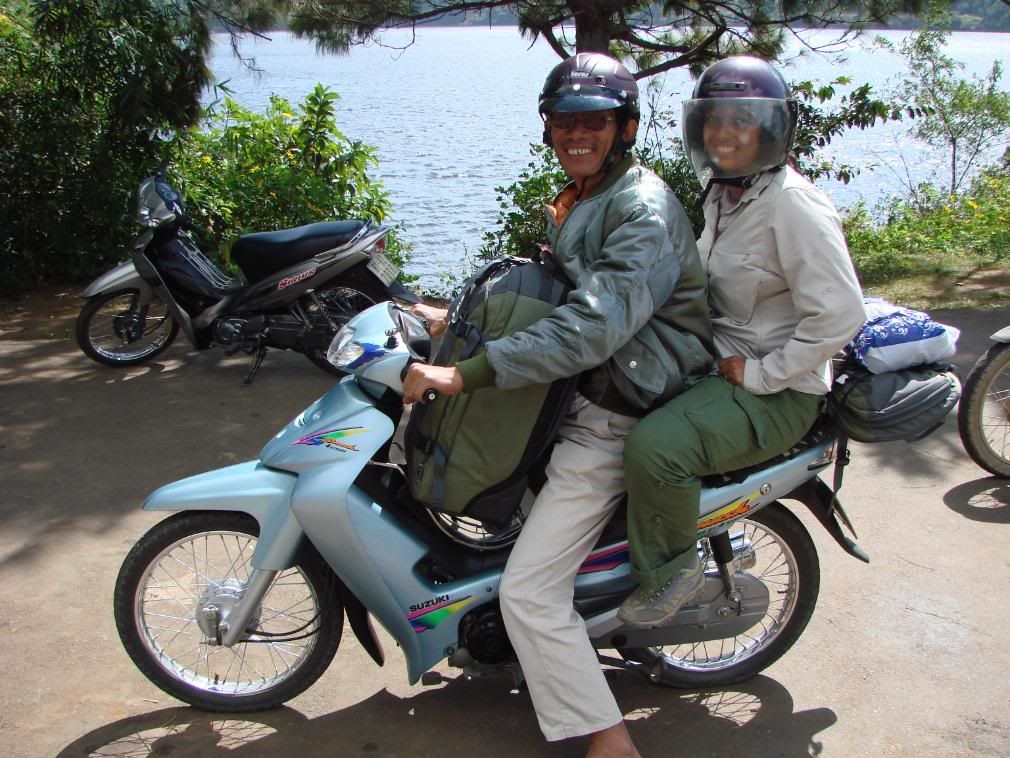 When we saw Duong’s replacement, a local who spoke no English and had a scooter rather than a motorbike, we knew immediately that our tour would be ending earlier than expected. Of course, since we’d paid for three days up front, we were pretty much stuck that day, knowing our chances of getting refunded were nil. It took over an hour just to get Priti’s bag secured onto the scooter so we got a late start to what was to be the longest day in terms of distance: over 200 kms (120 miles). To those used to U.S. Interstates, that may not seem like much, but in Vietnam that is a vast expanse, especially on a scooter. One of the bikes also had a flat tire that needed repaired. Thus, due to our late start, rather than stopping every half hour, as Duong had the first two days to give our bums a rest, we stopped about every 90-120 minutes. And instead of funny anecdotes, Hong’s broken English mostly eluded us. The afternoon became so painful that each of us was counting the kms until our arrival, even gauging our speed by counting the seconds between each marker. One scary moment came when Hong and another driver were weaving through a herd of cows that were crossing the road, and one of them backed right into Jason’s leg, nearly spilling them off the motorbike. Jason also suffered windburn on his face since his helmet had no faceguard. Priti’s helmet from the replacement driver was too big so it offered virtually no protection. She had scary thoughts about frontal lobe damage if there was an accident. During our breaks, we planned our exit strategy and braced ourselves for the totally uncomfortable evening we were about to endure. On the one hand, we felt guilty about canceling the tour early; given the devotion the Vietnamese have to their ancestors, we doubted Duong’s absence was fabricated. On the other, much larger hand, we recalled his comment about ending tours early, and Hong had flat-out lied to us about finding another Easy Rider.
When we saw Duong’s replacement, a local who spoke no English and had a scooter rather than a motorbike, we knew immediately that our tour would be ending earlier than expected. Of course, since we’d paid for three days up front, we were pretty much stuck that day, knowing our chances of getting refunded were nil. It took over an hour just to get Priti’s bag secured onto the scooter so we got a late start to what was to be the longest day in terms of distance: over 200 kms (120 miles). To those used to U.S. Interstates, that may not seem like much, but in Vietnam that is a vast expanse, especially on a scooter. One of the bikes also had a flat tire that needed repaired. Thus, due to our late start, rather than stopping every half hour, as Duong had the first two days to give our bums a rest, we stopped about every 90-120 minutes. And instead of funny anecdotes, Hong’s broken English mostly eluded us. The afternoon became so painful that each of us was counting the kms until our arrival, even gauging our speed by counting the seconds between each marker. One scary moment came when Hong and another driver were weaving through a herd of cows that were crossing the road, and one of them backed right into Jason’s leg, nearly spilling them off the motorbike. Jason also suffered windburn on his face since his helmet had no faceguard. Priti’s helmet from the replacement driver was too big so it offered virtually no protection. She had scary thoughts about frontal lobe damage if there was an accident. During our breaks, we planned our exit strategy and braced ourselves for the totally uncomfortable evening we were about to endure. On the one hand, we felt guilty about canceling the tour early; given the devotion the Vietnamese have to their ancestors, we doubted Duong’s absence was fabricated. On the other, much larger hand, we recalled his comment about ending tours early, and Hong had flat-out lied to us about finding another Easy Rider.
Upon arriving at the guest house, we informed Hong of our decision and, although he looked disappointed, he seemed to take it in stride and even invited us to dinner, which were these delicious spring rolls of pork and veggies wrapped in rice paper (Nem Nuong). As dinner winded down, Hong gathered the nerve to ask us what he’d been planning to since we’d informed him we were done with the trip—to pay for the remainder of it! Flabbergasted, we started out by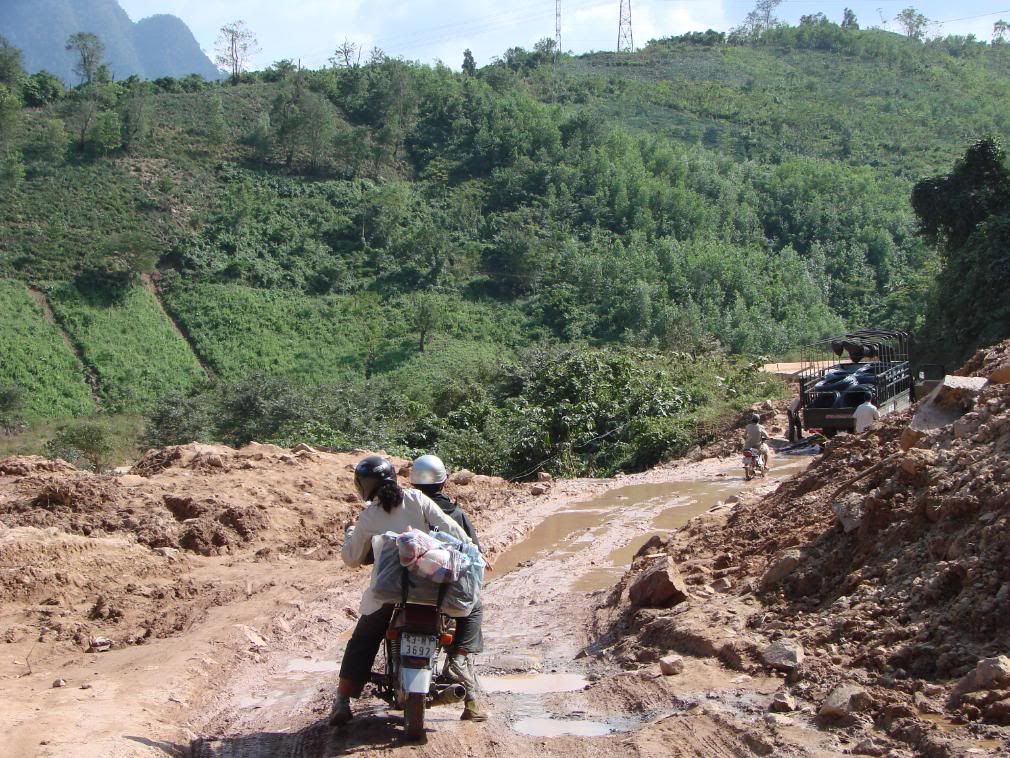 apologizing and assuring him it wasn’t his fault but he then called his boss, who tried to argue that we had to uphold our “contract”, despite the fact that the person on their end who signed the contract was no longer present. Besides, the contract was for a “sight seeing tour with English speaking guides” on motorbikes; a scooter is not a motorcycle, and we no longer had English speaking guides. The conversation persisted for over an hour as Hong tried to use every possible means of manipulation he could muster with his limited English skills while we looked at him with that mixture of incredulity, bemusement, and RAGE with which we had grown accustomed. Finally, Priti had had it and yelled at him in the restaurant and then stormed out. Jason tried to keep the atmosphere amicable but he too began to sense it was once again all about the money and both of us finally gave up on this country of which we had such high hopes. We demanded the hotel give us a receipt for the room, since Hong had claimed to pay for it, but we know he made it back when they completely ripped us off on our onward bus ticket. But, we were just happy to be moving on and from that night forward we no longer cared what we saw and just counted down the days, like kilometers, until we left Vietnam.
apologizing and assuring him it wasn’t his fault but he then called his boss, who tried to argue that we had to uphold our “contract”, despite the fact that the person on their end who signed the contract was no longer present. Besides, the contract was for a “sight seeing tour with English speaking guides” on motorbikes; a scooter is not a motorcycle, and we no longer had English speaking guides. The conversation persisted for over an hour as Hong tried to use every possible means of manipulation he could muster with his limited English skills while we looked at him with that mixture of incredulity, bemusement, and RAGE with which we had grown accustomed. Finally, Priti had had it and yelled at him in the restaurant and then stormed out. Jason tried to keep the atmosphere amicable but he too began to sense it was once again all about the money and both of us finally gave up on this country of which we had such high hopes. We demanded the hotel give us a receipt for the room, since Hong had claimed to pay for it, but we know he made it back when they completely ripped us off on our onward bus ticket. But, we were just happy to be moving on and from that night forward we no longer cared what we saw and just counted down the days, like kilometers, until we left Vietnam.
After a long day on a bus, we reached the mountainous city of Dalat. The word that is ubiquitously associated with Dalat is kitsch, and for good reason. Sitting atop the central highlands, Dalat looks over the rest of Vietnam as if from another continent, perhaps Europe or even North America, with its scenic pine forests and vacation homes perched atop each hill. One of Jason’s favorite authors, Milan Kundera, discusses kitsch at length in his novel, The Book of Laughter and Forgetting, in reference to the Communists in the Czech Republic. In Dalat, Jason finally understood the true meaning of kitsch, as vainglorious fountains adorned ponds that sat adjacent to sewage-covered ghettos, and trees lining the lake took up the entire sidewalk for no apparent reason. Another fine example is the so-called "Crazy House" that is under construction. Nevertheless, it was a beautiful city and full of outdoor activities such as mountain biking, rockclimbing, and kayaking. Of course, when Jason went to book a mountain biking excursion, it was both completely overpriced and booked up until our departure. At least we enjoyed a fabulous dinner of curry with freshwater eel and got to sample a variety of dried fruits at the local market, including strawberries, kiwis, and Jason’s favorite, sweet potato. At night, Jason hung out with a couple Americans who had some crazy travel stories about Central America including having machine guns pointed at them in El Salvador by the Frito Banditos (literally, the guards were protecting a truck filled with snack foods)!
One of Jason’s favorite authors, Milan Kundera, discusses kitsch at length in his novel, The Book of Laughter and Forgetting, in reference to the Communists in the Czech Republic. In Dalat, Jason finally understood the true meaning of kitsch, as vainglorious fountains adorned ponds that sat adjacent to sewage-covered ghettos, and trees lining the lake took up the entire sidewalk for no apparent reason. Another fine example is the so-called "Crazy House" that is under construction. Nevertheless, it was a beautiful city and full of outdoor activities such as mountain biking, rockclimbing, and kayaking. Of course, when Jason went to book a mountain biking excursion, it was both completely overpriced and booked up until our departure. At least we enjoyed a fabulous dinner of curry with freshwater eel and got to sample a variety of dried fruits at the local market, including strawberries, kiwis, and Jason’s favorite, sweet potato. At night, Jason hung out with a couple Americans who had some crazy travel stories about Central America including having machine guns pointed at them in El Salvador by the Frito Banditos (literally, the guards were protecting a truck filled with snack foods)!
Our last stop was Ho Chi Minh City or Saigon; it seemed whenever we said one the other person repeated back the other. We’d been warned by Lonely Planet that the thieves were the best in the country so we discussed staying on guard before leaving our guest house. On the first main street we came too, a group of young boys came up and we immediately secured our valuables. One of them asked for a high five so Jason gave him one with the hand that wasn’t holding his wallet. After booking a one-day tour of the Mekong Delta (we’d originally planned a longer tour but we refused to be fooled again), we set off in search for a restaurant also listed in the guidebook that didn’t seem too far away. An hour later, we stood in front of the address listed, grrrr. We finally sat down to dinner when Jason realized that a pack of clove cigarettes in his pant pockets were missing; the group of kids had swiped them! Clever devils, we had to hand it to them, but at least they didn’t get much.
We kept our expectations at ground-level for our final tour of the Mekong Delta. Thus, we were pleasantly surprised when our guide actually spoke English and even told some jokes. But, he was somehow the guide of two boats full of people and when he jumped on the other boat, we lost our guide. We just had to laugh. Of course, the one thing we hoped to see were the floating markets but by the time we arrived they had ended. 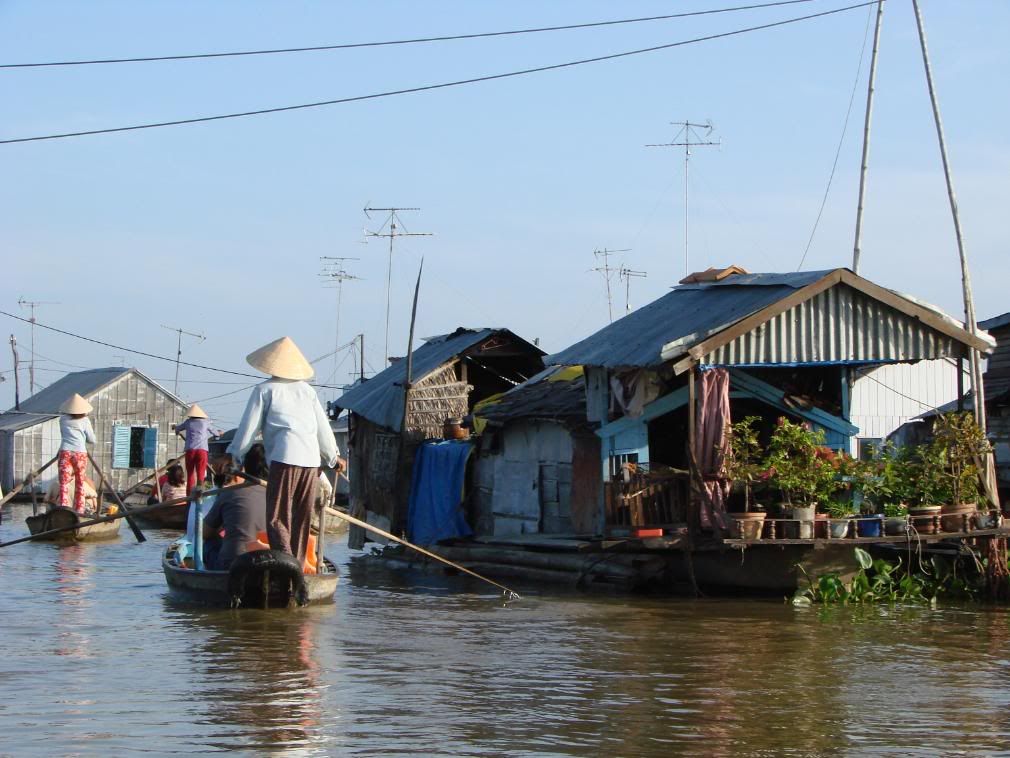 That evening we hung out with Jon, from Hollywood, and Brefanie from Ireland. Thus, on our last night in Vietnam, we learned what had happened to the Chinese couple we had met on our “tour” in Halong Bay. While everyone else was up on the top deck, two of the staff busted in and harassed the woman while she was sitting on the toilet. Priti tried to imagine the trauma this must have induced for this poor woman while Jason considered the violence that would have ensued had it been us. The next morning Brefanie’s room flooded which reminded us of our flooded cabin on the Halong Bay boat. Breffnie joined us in counting down the hours left until we were out of Vietnam and in Cambodia. As we cruised through the Delta, it was interesting to see the boat villages but this writer is ready to finally put these memories behind him. When we finally crossed the border, we gave Vietnam a final piece of our minds, and the giggles from the Cambodian children told us we weren’t the first to offer that salutation. (Warning: picture of salutation, located in the Cambodia gallery, is not appropriate for viewers under the age of thirteen.) For those of you who have seen Team America, we actually came up with alternate lyrics for the main them, replacing ‘America’ with ‘Vietnam’, and ’yeah’ with ‘you.’
That evening we hung out with Jon, from Hollywood, and Brefanie from Ireland. Thus, on our last night in Vietnam, we learned what had happened to the Chinese couple we had met on our “tour” in Halong Bay. While everyone else was up on the top deck, two of the staff busted in and harassed the woman while she was sitting on the toilet. Priti tried to imagine the trauma this must have induced for this poor woman while Jason considered the violence that would have ensued had it been us. The next morning Brefanie’s room flooded which reminded us of our flooded cabin on the Halong Bay boat. Breffnie joined us in counting down the hours left until we were out of Vietnam and in Cambodia. As we cruised through the Delta, it was interesting to see the boat villages but this writer is ready to finally put these memories behind him. When we finally crossed the border, we gave Vietnam a final piece of our minds, and the giggles from the Cambodian children told us we weren’t the first to offer that salutation. (Warning: picture of salutation, located in the Cambodia gallery, is not appropriate for viewers under the age of thirteen.) For those of you who have seen Team America, we actually came up with alternate lyrics for the main them, replacing ‘America’ with ‘Vietnam’, and ’yeah’ with ‘you.’
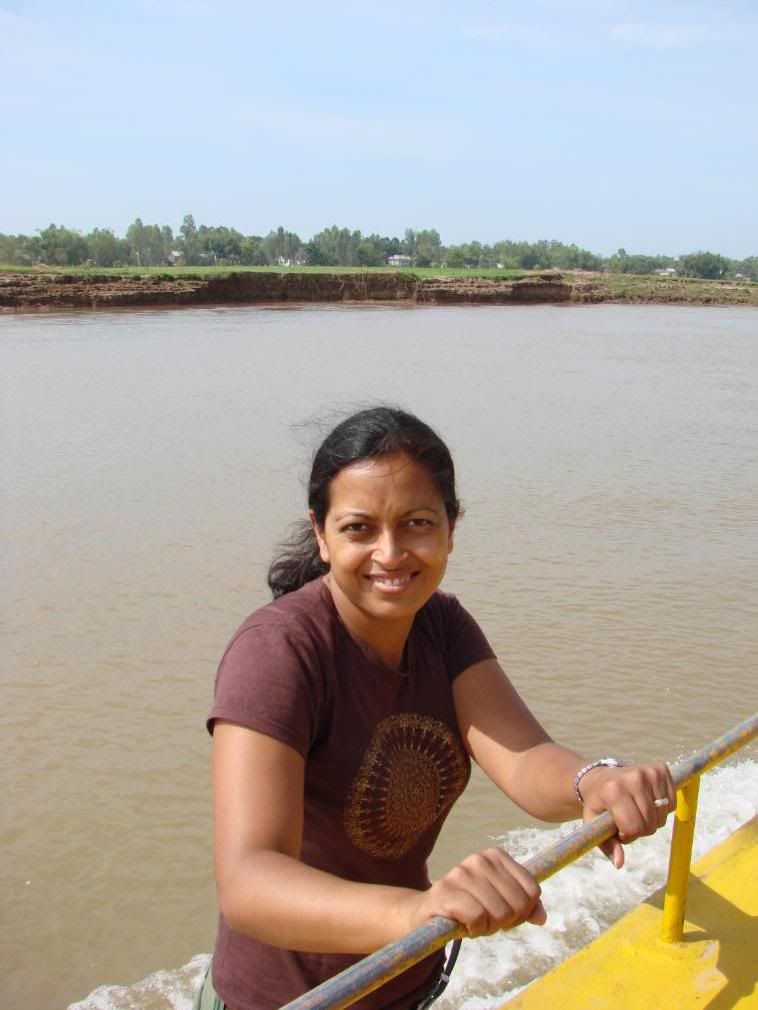 On the way we stopped at an ATM and were pleasantly surprised but slightly disturbed that the currency was U.S. dollars. We strolled along the river, and passed several small temples and dozens of homeless people, mostly children. We also came across "Bug Row", which was a street in the local market that was line with vendors selling all kinds of critters: crickets, tarantulas, grasshoppers, grubs, etc. Jason’s adventurous side came forward but we decided to hold off because we didn’t have the camera with us (and unfornutately never got around to getting a picture).
On the way we stopped at an ATM and were pleasantly surprised but slightly disturbed that the currency was U.S. dollars. We strolled along the river, and passed several small temples and dozens of homeless people, mostly children. We also came across "Bug Row", which was a street in the local market that was line with vendors selling all kinds of critters: crickets, tarantulas, grasshoppers, grubs, etc. Jason’s adventurous side came forward but we decided to hold off because we didn’t have the camera with us (and unfornutately never got around to getting a picture). 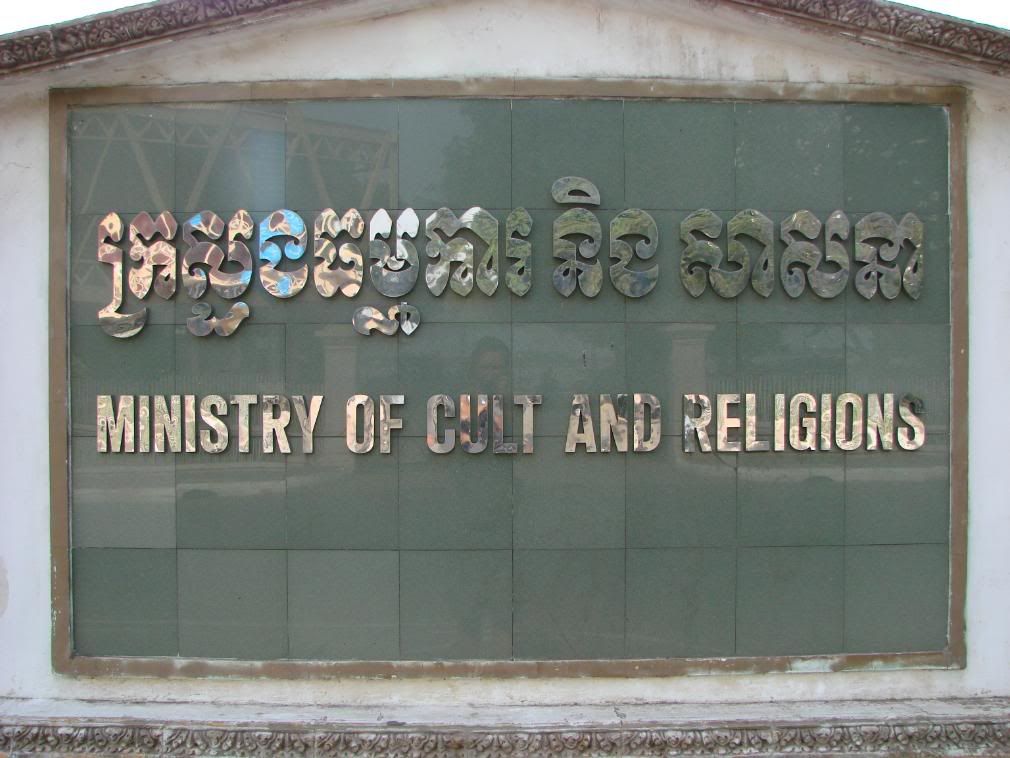 As we meandered through the city, we came across the Ministry of Cult and Religions which Jason found an apt coupling since he sees them as the same thing, but we couldn't go inside. For dinner, we enjoyed one of the local specialties, fish alok, which consisted of a mixture of lemongrass and coconut (basically Thai but milder). We also sampled the Ankor Beer, which was pretty good but no Beer Lao.
As we meandered through the city, we came across the Ministry of Cult and Religions which Jason found an apt coupling since he sees them as the same thing, but we couldn't go inside. For dinner, we enjoyed one of the local specialties, fish alok, which consisted of a mixture of lemongrass and coconut (basically Thai but milder). We also sampled the Ankor Beer, which was pretty good but no Beer Lao.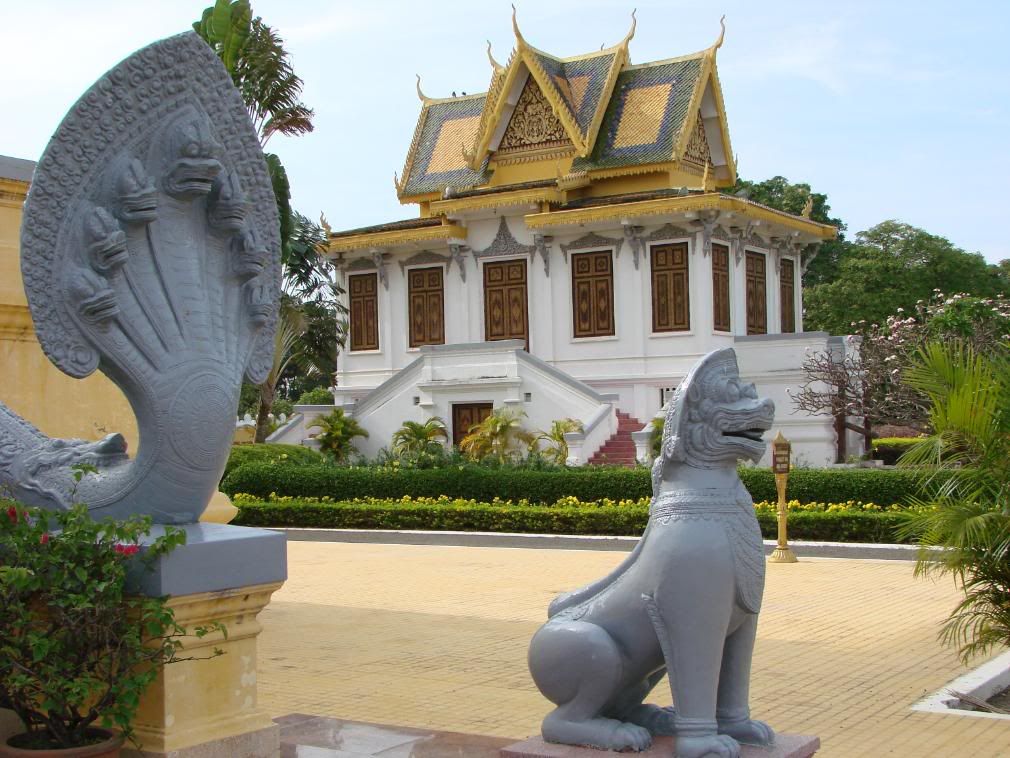 During the game, Jason would get his chance to sample one of the critters as one of the local women dialed in an order for a bag of crickets to go. Ten minutes later, they were sitting in front of him, waiting to be consumed. As he crunched into it, he was reminded of the dried salty sardines we had eaten in the Philippines. Jason managed to win some money despite the chips inexplicably being denominated in kip, the Khmer currency that no one uses except to provide change when less than $1. After collecting his winnings, he decided to head out with a New Yorker named Mark, who’d been living in Phnom Penh for four months. As they conversed, Jason brought up our upcoming travel plans to India, where Mark had spent several months traveling, specifically Ladakh. Jason mentioned that some friends had made a documentary about Buddhist mystics in Ladakh, and it turns out we were separated by just one degree, the inimitable Smitty (Ryan Smith)! We both were in awe as the interconnectedness of our planet planted itself right in our laps. Mark shared some interesting insights into the city which is famous for its lawlessness and frontier zeitgeist (think Wild West).
During the game, Jason would get his chance to sample one of the critters as one of the local women dialed in an order for a bag of crickets to go. Ten minutes later, they were sitting in front of him, waiting to be consumed. As he crunched into it, he was reminded of the dried salty sardines we had eaten in the Philippines. Jason managed to win some money despite the chips inexplicably being denominated in kip, the Khmer currency that no one uses except to provide change when less than $1. After collecting his winnings, he decided to head out with a New Yorker named Mark, who’d been living in Phnom Penh for four months. As they conversed, Jason brought up our upcoming travel plans to India, where Mark had spent several months traveling, specifically Ladakh. Jason mentioned that some friends had made a documentary about Buddhist mystics in Ladakh, and it turns out we were separated by just one degree, the inimitable Smitty (Ryan Smith)! We both were in awe as the interconnectedness of our planet planted itself right in our laps. Mark shared some interesting insights into the city which is famous for its lawlessness and frontier zeitgeist (think Wild West). 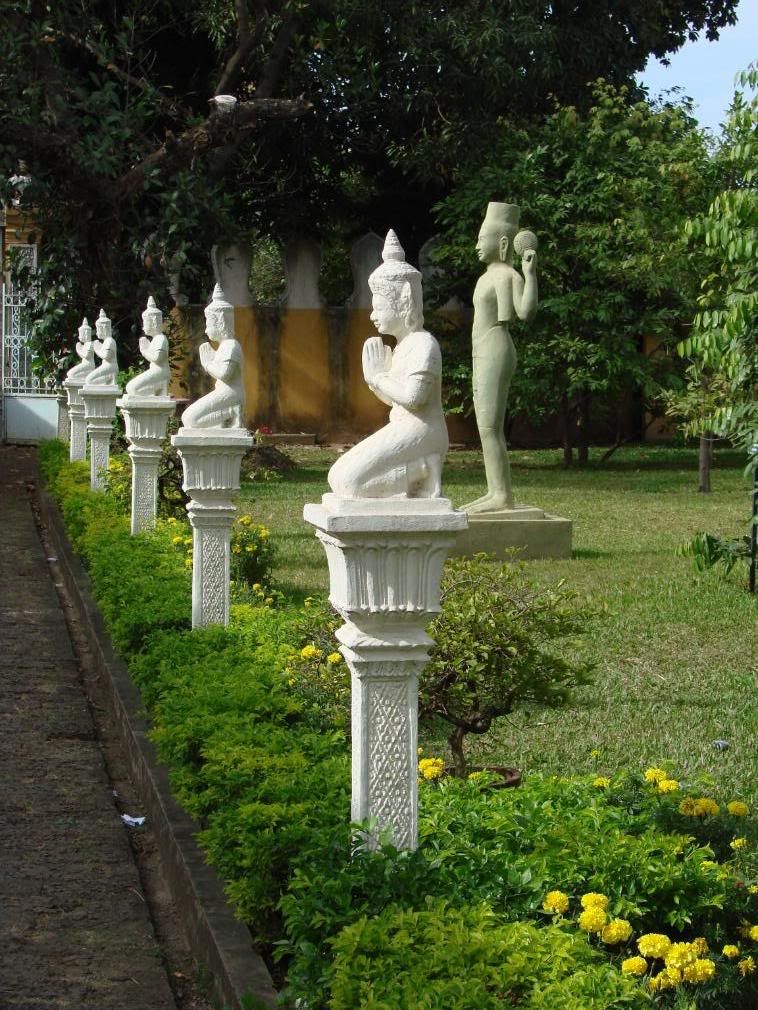 For example, there is one street, which we did not see, that is essentially ‘Prostitute Row’ and is lined with little warehouses filled with girls and boys as young as fourteen that will satisfy even the most depraved tourists. Cambodia is now one of the most popular countries for sex tourism because it is cheaper than Thailand (which is already very cheap) and Vietnam clamped down on the industry; many if not most of the prostitutes working in Cambodia (often having been enslaved) are actually Vietnamese. Jason was barely able to restrain himself when he saw men aged sixty or older holding hands with teenagers. More chillingly, at the hotel at which we were staying, which was huge and packed with backpackers, two tourists had been found dead in their room. Luckily, when we went out to another club, we didn’t witness firsthand this lawlessness and no one pulled their guns out (which is apparently a common occurrence).
For example, there is one street, which we did not see, that is essentially ‘Prostitute Row’ and is lined with little warehouses filled with girls and boys as young as fourteen that will satisfy even the most depraved tourists. Cambodia is now one of the most popular countries for sex tourism because it is cheaper than Thailand (which is already very cheap) and Vietnam clamped down on the industry; many if not most of the prostitutes working in Cambodia (often having been enslaved) are actually Vietnamese. Jason was barely able to restrain himself when he saw men aged sixty or older holding hands with teenagers. More chillingly, at the hotel at which we were staying, which was huge and packed with backpackers, two tourists had been found dead in their room. Luckily, when we went out to another club, we didn’t witness firsthand this lawlessness and no one pulled their guns out (which is apparently a common occurrence).  In 1975, upon their relatively easy defeat of the corrupt Sihanouk’s army, Pol Pot and his group of naïve revolutionaries then set about annihilating their country in order to form a Communist utopia. Their first move was to implement an asinine policy of evacuating all of the major cities and forcing literally everyone into the countryside. The rationale for this policy was that for too long city residents had exploited the farmers. Hundreds of thousands died during this phase alone. Those who survived faced in many cases an even worse fate, as they were stripped of all possessions (money was abolished) and forced into the hardest labor imaginable. One of the slogans often heard by these ‘new people,’ as displaced city residents were called, was ‘nothing is gained if you live, nothing is lost if you die.’ Pol Pot’s own paranoia was projected onto the entire country, as everyone was on guard for fear of being reported as a traitor.
In 1975, upon their relatively easy defeat of the corrupt Sihanouk’s army, Pol Pot and his group of naïve revolutionaries then set about annihilating their country in order to form a Communist utopia. Their first move was to implement an asinine policy of evacuating all of the major cities and forcing literally everyone into the countryside. The rationale for this policy was that for too long city residents had exploited the farmers. Hundreds of thousands died during this phase alone. Those who survived faced in many cases an even worse fate, as they were stripped of all possessions (money was abolished) and forced into the hardest labor imaginable. One of the slogans often heard by these ‘new people,’ as displaced city residents were called, was ‘nothing is gained if you live, nothing is lost if you die.’ Pol Pot’s own paranoia was projected onto the entire country, as everyone was on guard for fear of being reported as a traitor. 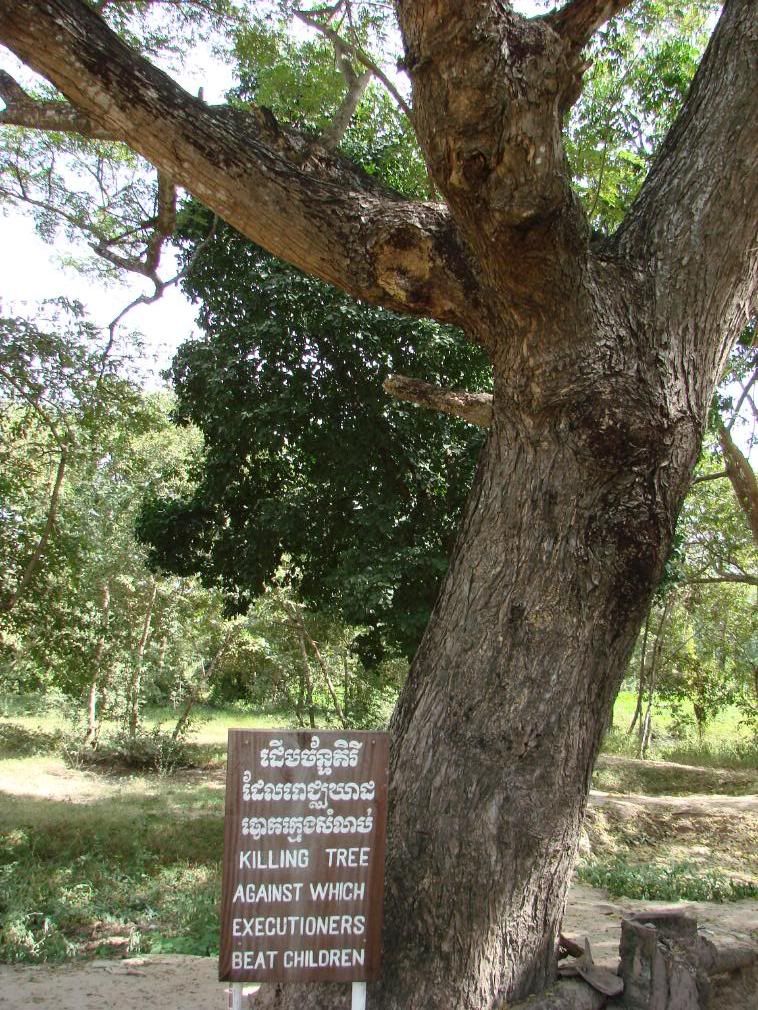 Children were indoctrinated to turn on their parents and even knowing someone who was suspected of minor wrongdoings was punishable by torture and death. Two years into their power, they ignited a full-on war with Vietnam that would ultimately destroy their regime two years later. Although they spent just four years in power, the Khmer Rouge were directly responsible for the deaths of over 1 million people, or about 1/7 of their population.
Children were indoctrinated to turn on their parents and even knowing someone who was suspected of minor wrongdoings was punishable by torture and death. Two years into their power, they ignited a full-on war with Vietnam that would ultimately destroy their regime two years later. Although they spent just four years in power, the Khmer Rouge were directly responsible for the deaths of over 1 million people, or about 1/7 of their population. 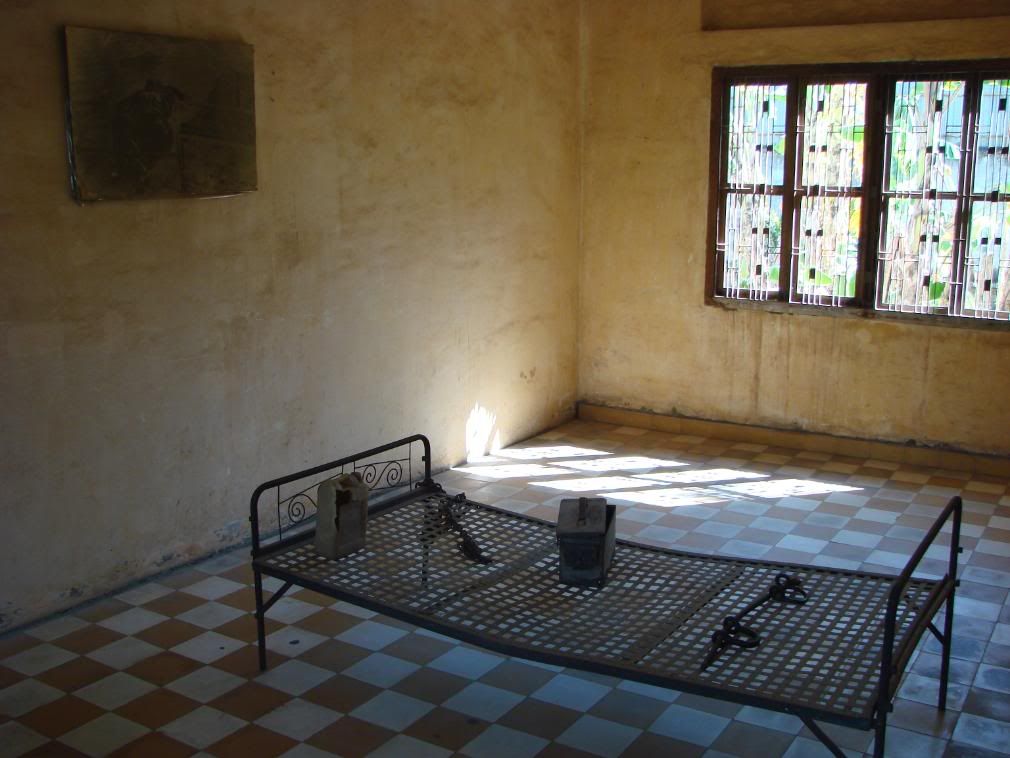 The next stop was Tuol Sleng, or S-21, which was a school that the Khmer Rouge turned into a prison. One three-story building consisted of a series of cells. On the first floor, each room had a single bed in the middle with various implements of torture chained to them. Graphic pictures on the wall showed the corpses that were left to rot in those very same beds. The 2nd and 3rd stories contained smaller cells that were about the size of closets, where other victims were held. The adjacent building contained room after room of portraits of the victims. We slowly moved through these rooms, entranced by the expressions on their faces: fear, resignation, anger, even hope that they might be spared. But of the more than 14,000 residents of S-21, there were just seven survivors. The faces of the child victims were the saddest of all.
The next stop was Tuol Sleng, or S-21, which was a school that the Khmer Rouge turned into a prison. One three-story building consisted of a series of cells. On the first floor, each room had a single bed in the middle with various implements of torture chained to them. Graphic pictures on the wall showed the corpses that were left to rot in those very same beds. The 2nd and 3rd stories contained smaller cells that were about the size of closets, where other victims were held. The adjacent building contained room after room of portraits of the victims. We slowly moved through these rooms, entranced by the expressions on their faces: fear, resignation, anger, even hope that they might be spared. But of the more than 14,000 residents of S-21, there were just seven survivors. The faces of the child victims were the saddest of all.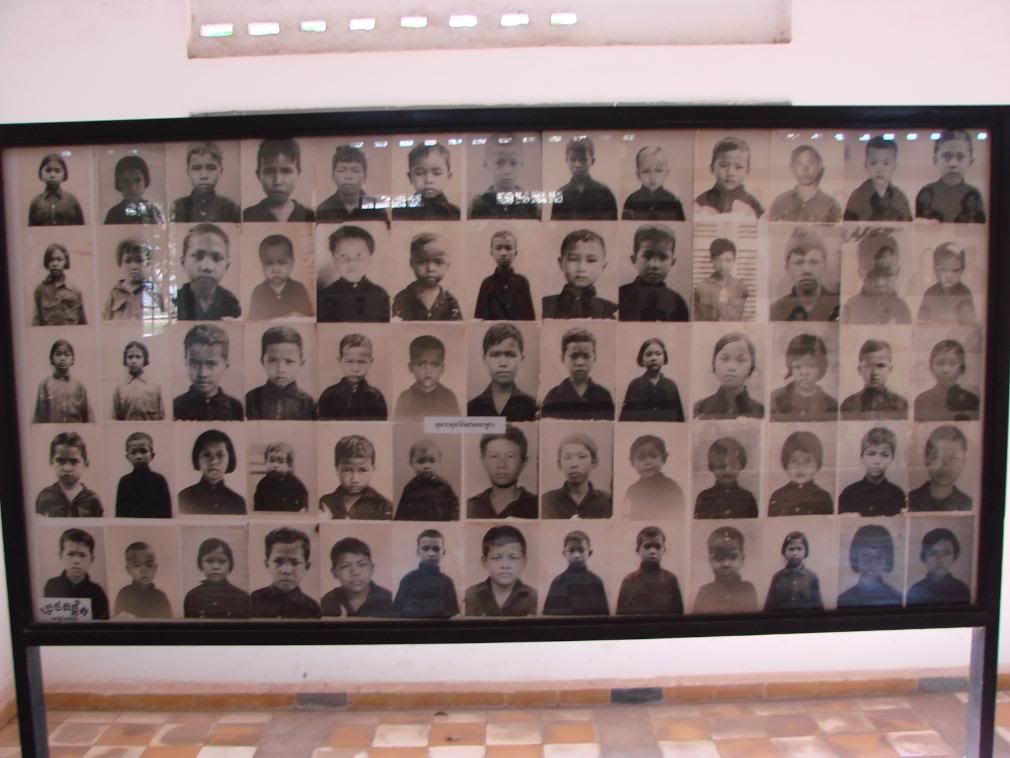 One fascinating aspect of the Khmer Rouge is that they maintained copious records of their victims, including lengthy confessions (some over 200 pages) that were generally extracted by torture. The most informative confessions were from Pol Pot’s inner circle, over half of whom were ultimately purged, even though some of them had been his ‘friends’ for two decades. Somehow, Pol Pot escaped death and lived in hiding and then house arrest until his death in 1998. Astoundingly, based on his comments shortly before his death, ‘everything I did, I did for my country,’ his conscience remained clear. But what’s even more astounding is that, according to Mark, the Khmer Rouge are still in power in much of the more remote areas of Cambodia.
One fascinating aspect of the Khmer Rouge is that they maintained copious records of their victims, including lengthy confessions (some over 200 pages) that were generally extracted by torture. The most informative confessions were from Pol Pot’s inner circle, over half of whom were ultimately purged, even though some of them had been his ‘friends’ for two decades. Somehow, Pol Pot escaped death and lived in hiding and then house arrest until his death in 1998. Astoundingly, based on his comments shortly before his death, ‘everything I did, I did for my country,’ his conscience remained clear. But what’s even more astounding is that, according to Mark, the Khmer Rouge are still in power in much of the more remote areas of Cambodia.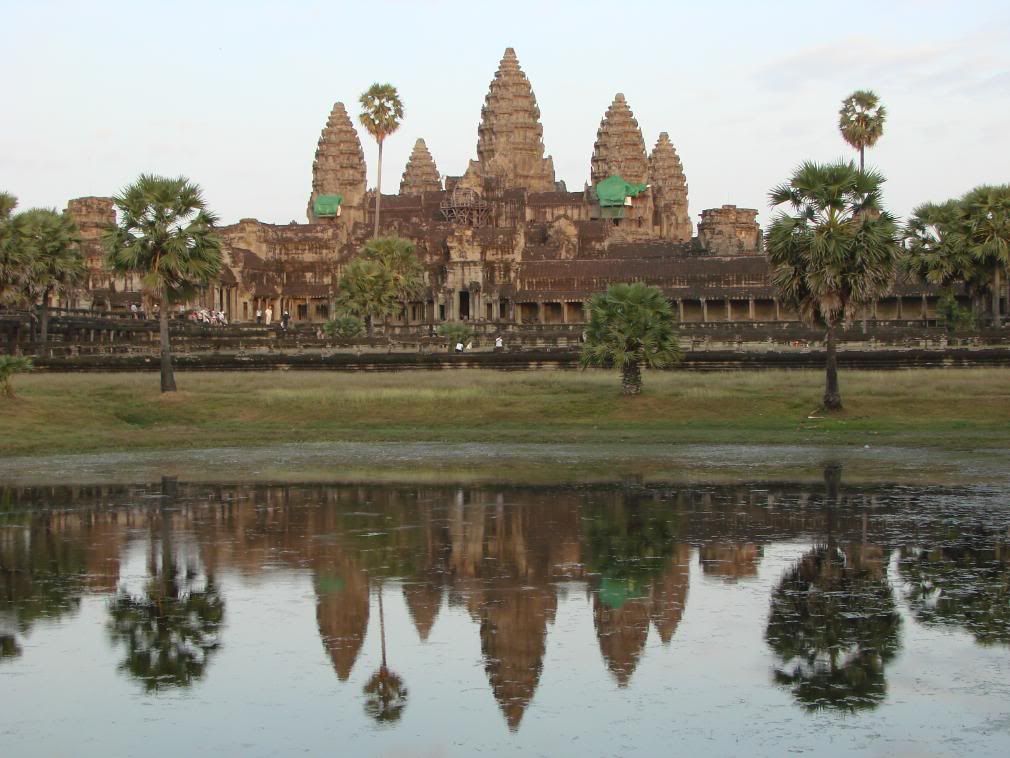 We opted for the three-day pass, which was a bit pricey at $40 but we knew that one day would not be enough and we wanted to take a relaxed pace rather than rush around trying to see everything. Upon our arrival, we purchased a guidebook called Ancient Angkor that we found invaluable in our explorations. Our first stop was Angkor Wat itself; with its triumvirate towers, it is the most well-known of the temples and is a ubiquitous symbol in the Khmer landscape, donning both the flag and the beer.
We opted for the three-day pass, which was a bit pricey at $40 but we knew that one day would not be enough and we wanted to take a relaxed pace rather than rush around trying to see everything. Upon our arrival, we purchased a guidebook called Ancient Angkor that we found invaluable in our explorations. Our first stop was Angkor Wat itself; with its triumvirate towers, it is the most well-known of the temples and is a ubiquitous symbol in the Khmer landscape, donning both the flag and the beer. 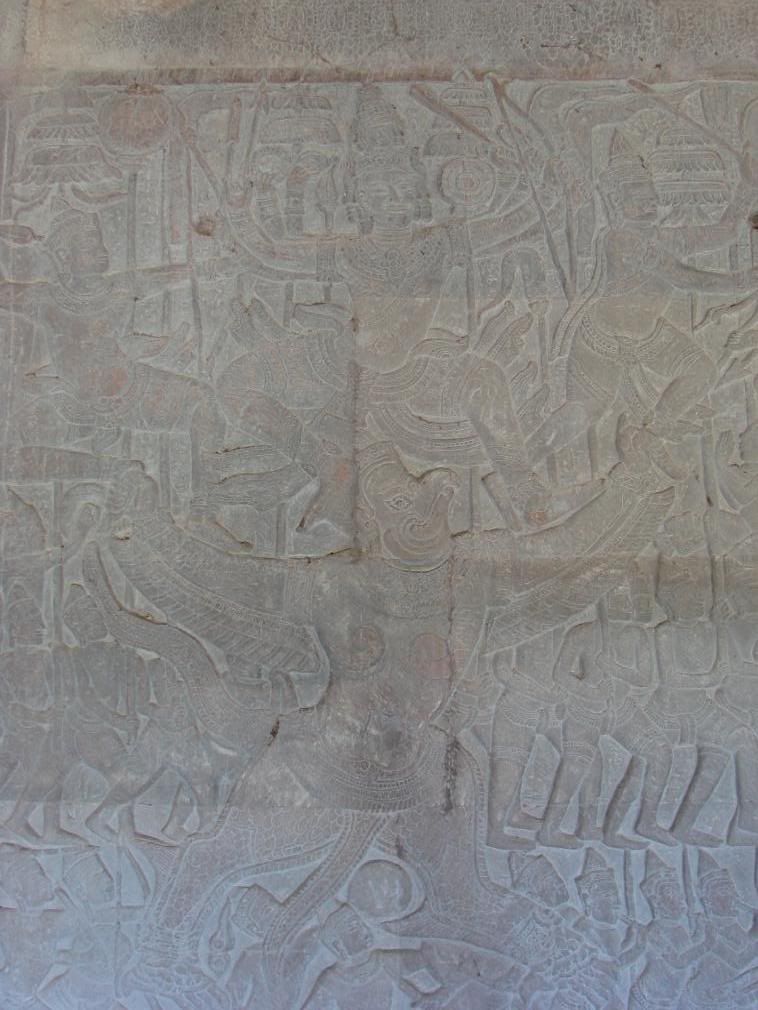 It is truly an amazing structure to behold and one of the most amazing things we’ve ever seen. Pol Pot was reported to have said, when informed that his production goals were impossible to meet, ‘if our people were capable of Angkor, we can do anything.’ Our amazement only grew when we entered the temple, as every wall was covered with detailed carvings called bas-reliefs. Most of the scenes were from Hindu mythology, including the Ramayana and Mahabharata.
It is truly an amazing structure to behold and one of the most amazing things we’ve ever seen. Pol Pot was reported to have said, when informed that his production goals were impossible to meet, ‘if our people were capable of Angkor, we can do anything.’ Our amazement only grew when we entered the temple, as every wall was covered with detailed carvings called bas-reliefs. Most of the scenes were from Hindu mythology, including the Ramayana and Mahabharata. 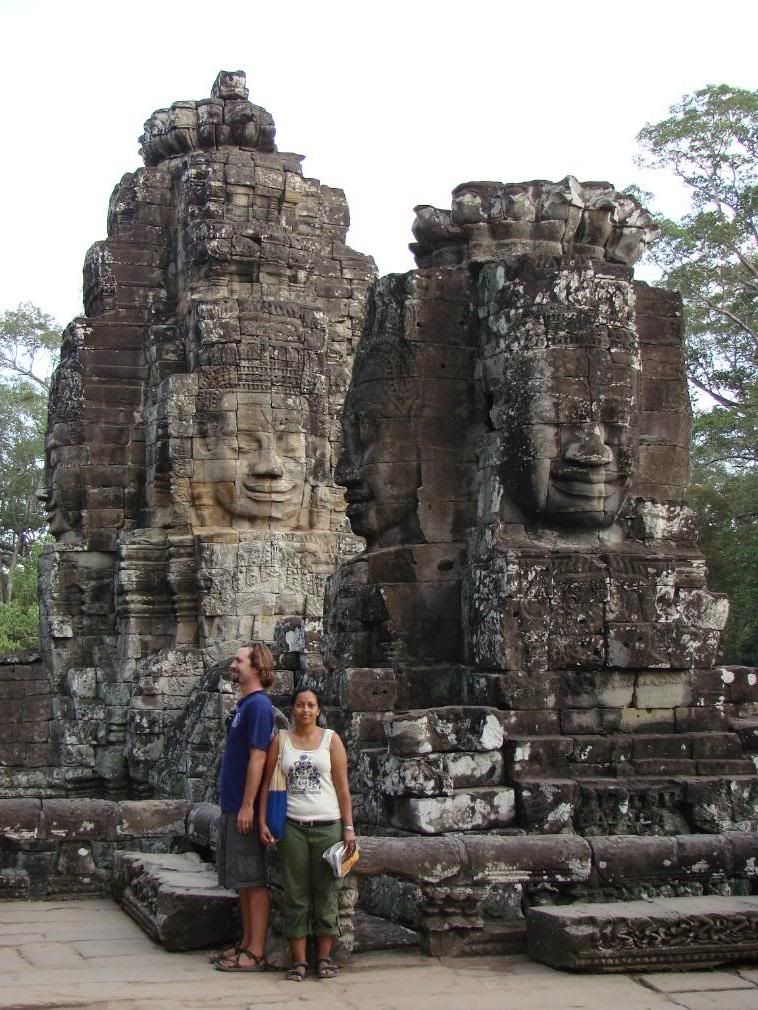 We lost count of the faces whose eyes seemed to follow us throughout the temple. We spent a couple more hours there and before we knew it the day was nearly over. For sunset, we reluctantly opted to join the crowds that gather each evening at a hilltop temple. On our way we stopped at both the Elephant and Leper King Terraces. After ascending the big hill, we had to climb up these huge steps that were so steep we had to use our hands.
We lost count of the faces whose eyes seemed to follow us throughout the temple. We spent a couple more hours there and before we knew it the day was nearly over. For sunset, we reluctantly opted to join the crowds that gather each evening at a hilltop temple. On our way we stopped at both the Elephant and Leper King Terraces. After ascending the big hill, we had to climb up these huge steps that were so steep we had to use our hands. 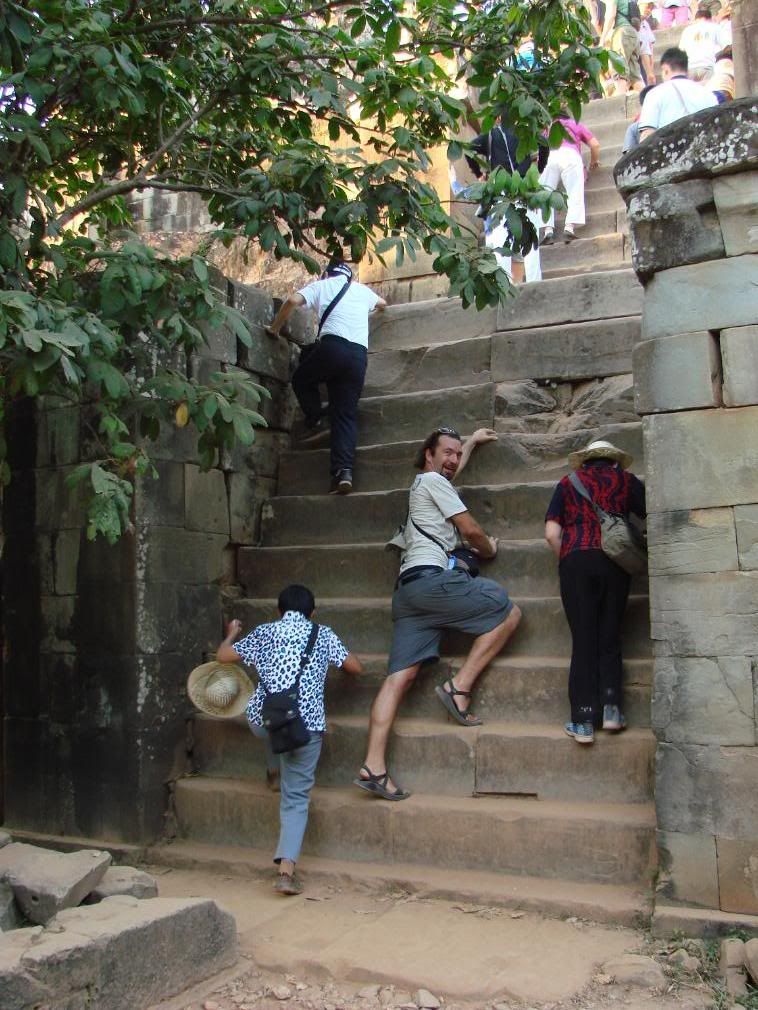 The sun setting behind the temple was nice and we got a good view of Angkor Wat from afar.
The sun setting behind the temple was nice and we got a good view of Angkor Wat from afar. 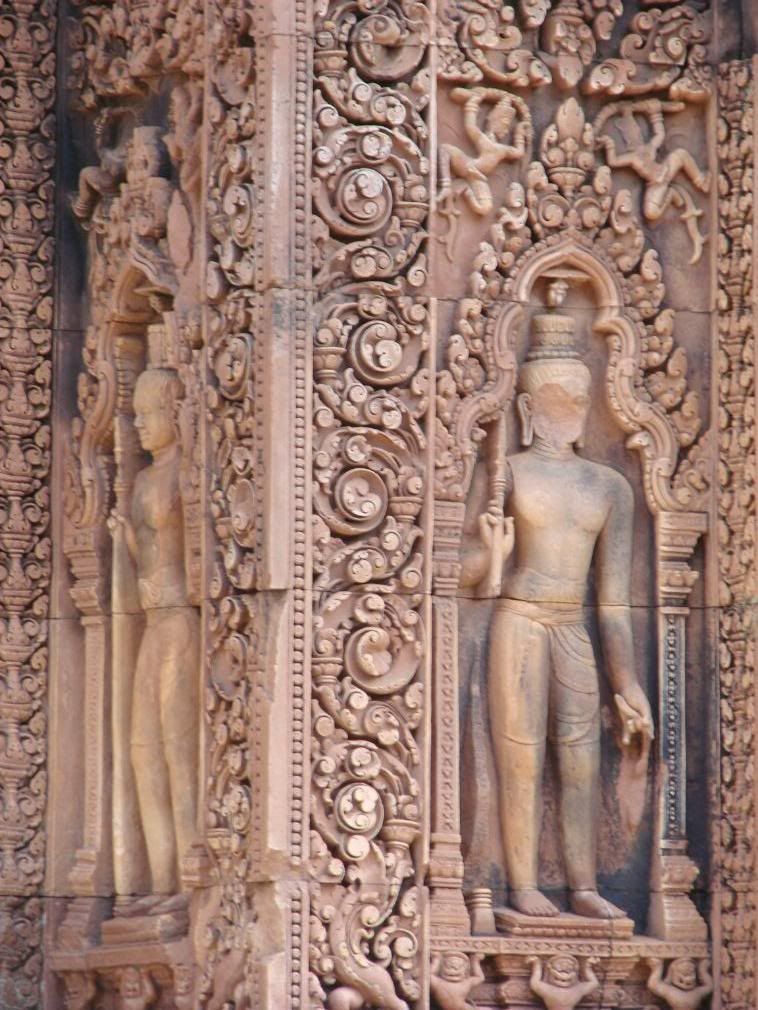 Along the way, we passed many villages, some of which had signs documenting some sort of adoption program by foreigners, most of whom were Americans. It was sad to see yet again dozens of beggin children, and as we were walking to one of the temples, one of them approached us so we gave some of our bananas to her. We hadn’t finished eating the remaining half when another girl approached us. When we offered her bananas, she exclaimed, "I’m not a monkey"(!) Needless to say, she went away empty-handed.
Along the way, we passed many villages, some of which had signs documenting some sort of adoption program by foreigners, most of whom were Americans. It was sad to see yet again dozens of beggin children, and as we were walking to one of the temples, one of them approached us so we gave some of our bananas to her. We hadn’t finished eating the remaining half when another girl approached us. When we offered her bananas, she exclaimed, "I’m not a monkey"(!) Needless to say, she went away empty-handed.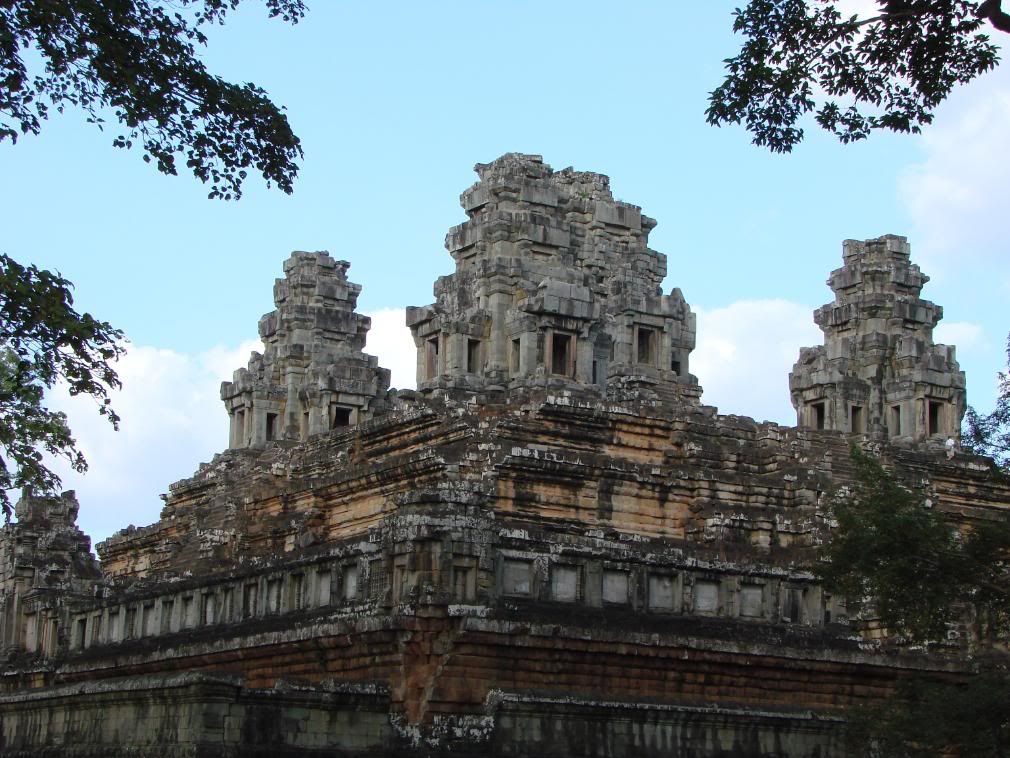 The center of the silver grill had a slab of lard on it which melted and marinated the meat surrounding it. The barbeque was silver and dome shaped so that the meat could be on it. We also enjoyed some Beer Lao and then biked home at a reasonable hour yet we somehow didn’t go to bed until close to midnight. Thus, when the alarm sounded at 5am, we were too tired to get out of bed and ride our bikes to see the sunrise. We got up around eight instead and got ready for a leisurely day of biking. We noticed a wrench on Jason’s bike, which was parked in front of the guesthouse, and then he realized the seat position was lower and the seat had mysteriously suffered a broken shock, making it very uncomfortable to ride. Actually it wasn’t much of a mystery as we knew the seat had been replaced with a broken one. We talked to the guesthouse manager who said the wrench was his but wasn’t sure what had happened to the seat.
The center of the silver grill had a slab of lard on it which melted and marinated the meat surrounding it. The barbeque was silver and dome shaped so that the meat could be on it. We also enjoyed some Beer Lao and then biked home at a reasonable hour yet we somehow didn’t go to bed until close to midnight. Thus, when the alarm sounded at 5am, we were too tired to get out of bed and ride our bikes to see the sunrise. We got up around eight instead and got ready for a leisurely day of biking. We noticed a wrench on Jason’s bike, which was parked in front of the guesthouse, and then he realized the seat position was lower and the seat had mysteriously suffered a broken shock, making it very uncomfortable to ride. Actually it wasn’t much of a mystery as we knew the seat had been replaced with a broken one. We talked to the guesthouse manager who said the wrench was his but wasn’t sure what had happened to the seat. 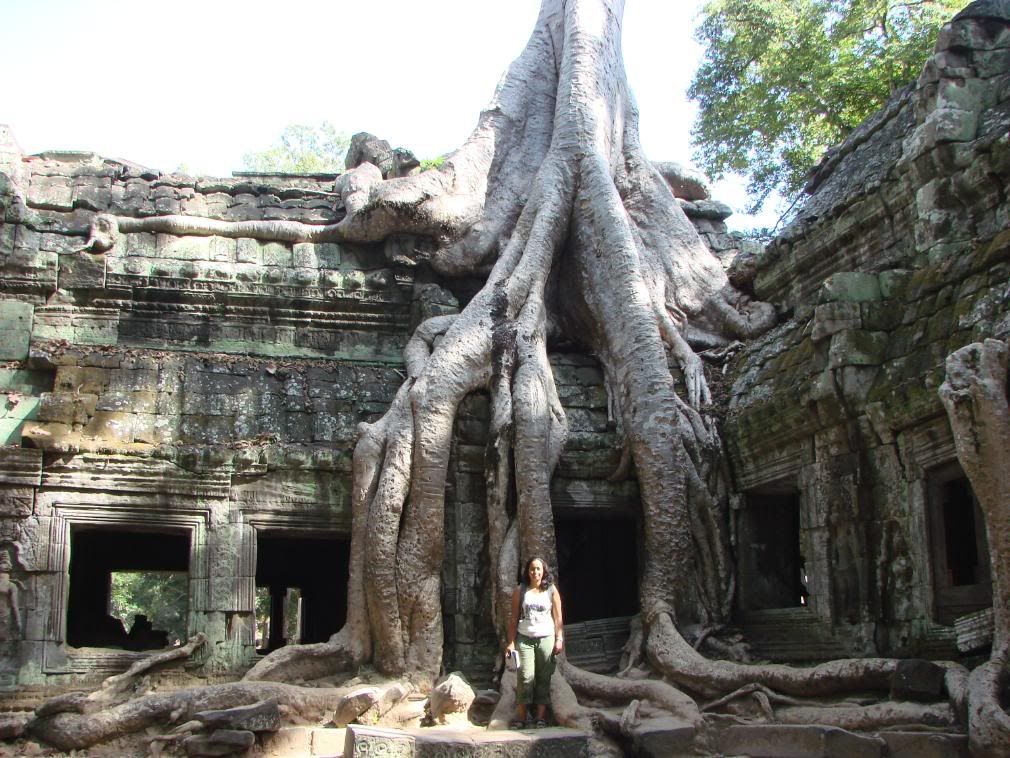 Fortunately we got a replacement without any hassle and then rode off to the Wats. It was a beautiful day with clear skies and a nice wind that kept us cool. This continued the pattern that every time we rent bikes we have great days. The highlight of the day was Ta Prohm, which had lots of trees growing right out of the ruins. At the same time, we were disappointed that some of the temples were in pretty bad shape, considering how much revenue is received each year from tourism. It was even more frustrating because we had received false information that the Temples were owned by the Vietnamese! That evening, we had planned to cap our stay in Siem Reap with a classical music concert that is held at the local children’s hospital every Saturday night. However, when we showed the guesthouse manager the flier, he informed us that it was actually Sunday. This means we had been off by a day for the past week…doh!
Fortunately we got a replacement without any hassle and then rode off to the Wats. It was a beautiful day with clear skies and a nice wind that kept us cool. This continued the pattern that every time we rent bikes we have great days. The highlight of the day was Ta Prohm, which had lots of trees growing right out of the ruins. At the same time, we were disappointed that some of the temples were in pretty bad shape, considering how much revenue is received each year from tourism. It was even more frustrating because we had received false information that the Temples were owned by the Vietnamese! That evening, we had planned to cap our stay in Siem Reap with a classical music concert that is held at the local children’s hospital every Saturday night. However, when we showed the guesthouse manager the flier, he informed us that it was actually Sunday. This means we had been off by a day for the past week…doh! 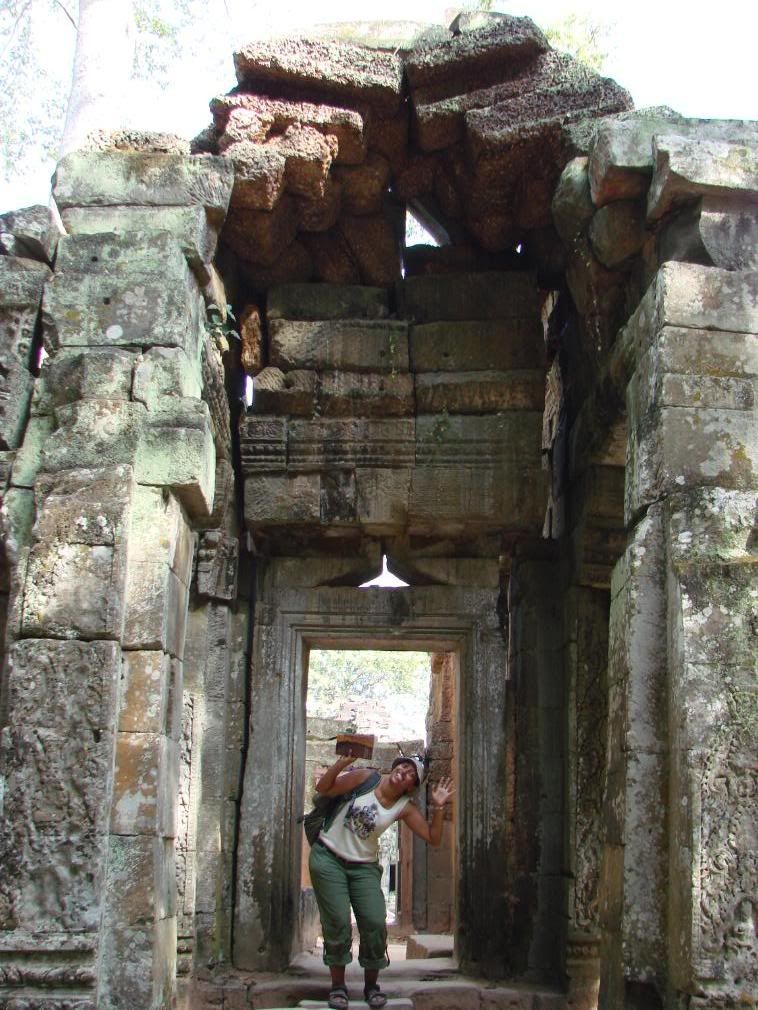 At first, it was just dust on the bags, but after several toilet stops, the dust became mud. The one in the very front got the worst of it, which by the end had a layer of toxic mud caked onto it. Other passengers commented how sorry they felt for the owner who just happened to be Jason. When one young female dolt made the completely asinine and insensitive remark, "I hope no one has anything valuable in their bag" as she proceeded to walk all over them, Jason had to once again summon all his restraint in order not to push her off the bus. At this point Jason would like to mention that he is keeping a record of the most annoying people we’ve met on our trip and she will no doubt occupy a prime spot.
At first, it was just dust on the bags, but after several toilet stops, the dust became mud. The one in the very front got the worst of it, which by the end had a layer of toxic mud caked onto it. Other passengers commented how sorry they felt for the owner who just happened to be Jason. When one young female dolt made the completely asinine and insensitive remark, "I hope no one has anything valuable in their bag" as she proceeded to walk all over them, Jason had to once again summon all his restraint in order not to push her off the bus. At this point Jason would like to mention that he is keeping a record of the most annoying people we’ve met on our trip and she will no doubt occupy a prime spot.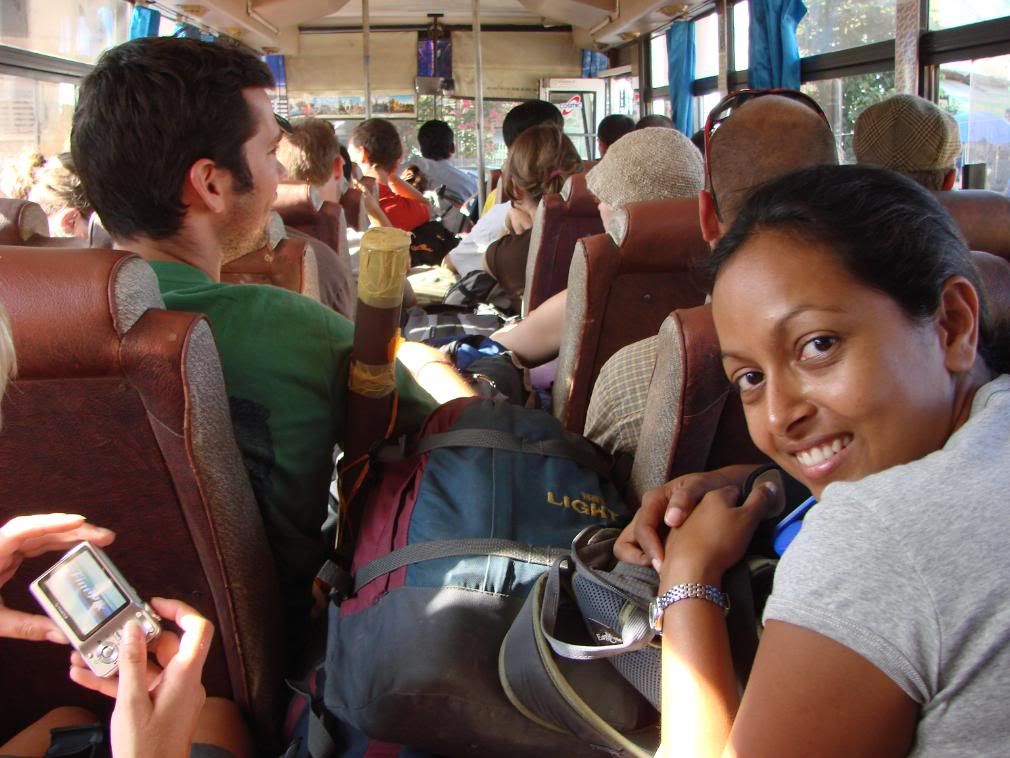 While waiting we watched in disgust as a young boy, probably the age of 5 or 6, was holding a baby strapped to him like a beat up rag-doll. He almost dropped the baby numerous times and his gap-toothed grin seemed to widen with each near drop. Jason wanted to reach out and throttle him but we just had to look the other way. We wondered why these kids didn’t sell bottles of water or something useful instead of just begging for money. After waiting for so long, we were relieved to get onto a bus that actually was air conditioned and drove for 4 more hours to finally reach Bangkok. The total trip took 13 hours but felt like 31 although it could have been worse we figured after seeing this.
While waiting we watched in disgust as a young boy, probably the age of 5 or 6, was holding a baby strapped to him like a beat up rag-doll. He almost dropped the baby numerous times and his gap-toothed grin seemed to widen with each near drop. Jason wanted to reach out and throttle him but we just had to look the other way. We wondered why these kids didn’t sell bottles of water or something useful instead of just begging for money. After waiting for so long, we were relieved to get onto a bus that actually was air conditioned and drove for 4 more hours to finally reach Bangkok. The total trip took 13 hours but felt like 31 although it could have been worse we figured after seeing this.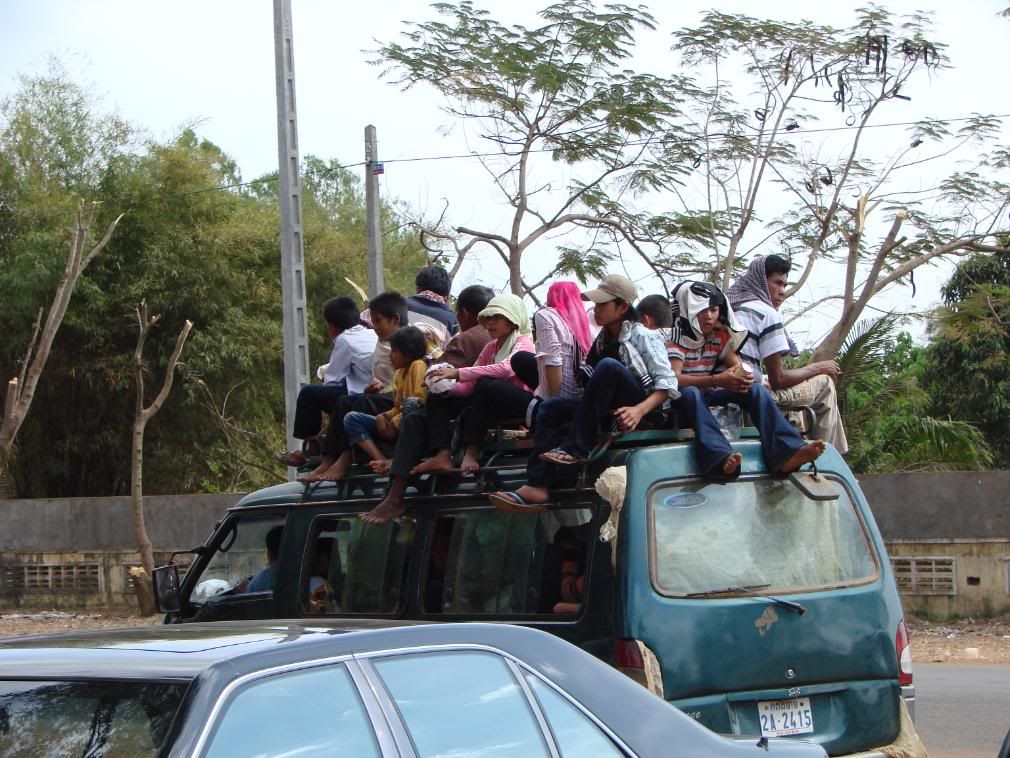 We imagined taking this bus the other way and how awful it must be for people to endure this ride and then be greeted in Cambodia by the insanity at the bus station. Other travelers we’d met had their entire stays in Cambodia ruined because of a negative chain-reaction, like we had experienced in Vietnam. If any of you plan to head to Siem Reap from Thailand, we highly recommend you take the flight rather than risk ruining your entire perceptions of what will hopefully once again be a great country.
We imagined taking this bus the other way and how awful it must be for people to endure this ride and then be greeted in Cambodia by the insanity at the bus station. Other travelers we’d met had their entire stays in Cambodia ruined because of a negative chain-reaction, like we had experienced in Vietnam. If any of you plan to head to Siem Reap from Thailand, we highly recommend you take the flight rather than risk ruining your entire perceptions of what will hopefully once again be a great country.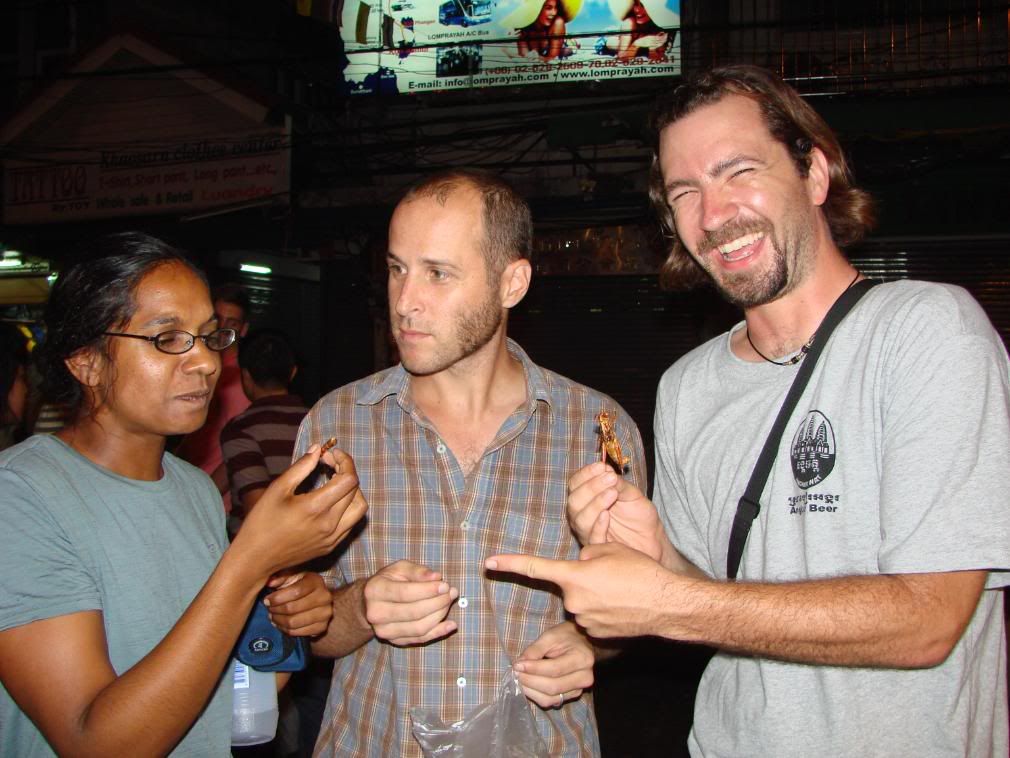 ‘We’ in this instance doesn’t include Priti, as she refused to partake in the exotic snacks. Sapna was enthusiastic but quickly lost it after crunching into her first critter. Jason and Paul chomped on the roasted roaches, grubs and grasshoppers and Jason even got another order of the latter, which he claimed tasted like soy-flavored potato crisps. Also, his distaste for roaches has dissipated since once you’ve eaten them, they lose their gross-out power. J Then we wandered around the area and Jason managed to find a Big Lebowski shirt with a picture of the Dude above the caption ‘The Dude Abides.’ Sapna found it hysterical and had successfully predicted that he would be buying at least one goofy t-shirt in Bangkok. Although we somehow managed not to talk about it, we found out later that they were taken by the same tuk-tuk scammer as us (see Thailand entry)!
‘We’ in this instance doesn’t include Priti, as she refused to partake in the exotic snacks. Sapna was enthusiastic but quickly lost it after crunching into her first critter. Jason and Paul chomped on the roasted roaches, grubs and grasshoppers and Jason even got another order of the latter, which he claimed tasted like soy-flavored potato crisps. Also, his distaste for roaches has dissipated since once you’ve eaten them, they lose their gross-out power. J Then we wandered around the area and Jason managed to find a Big Lebowski shirt with a picture of the Dude above the caption ‘The Dude Abides.’ Sapna found it hysterical and had successfully predicted that he would be buying at least one goofy t-shirt in Bangkok. Although we somehow managed not to talk about it, we found out later that they were taken by the same tuk-tuk scammer as us (see Thailand entry)!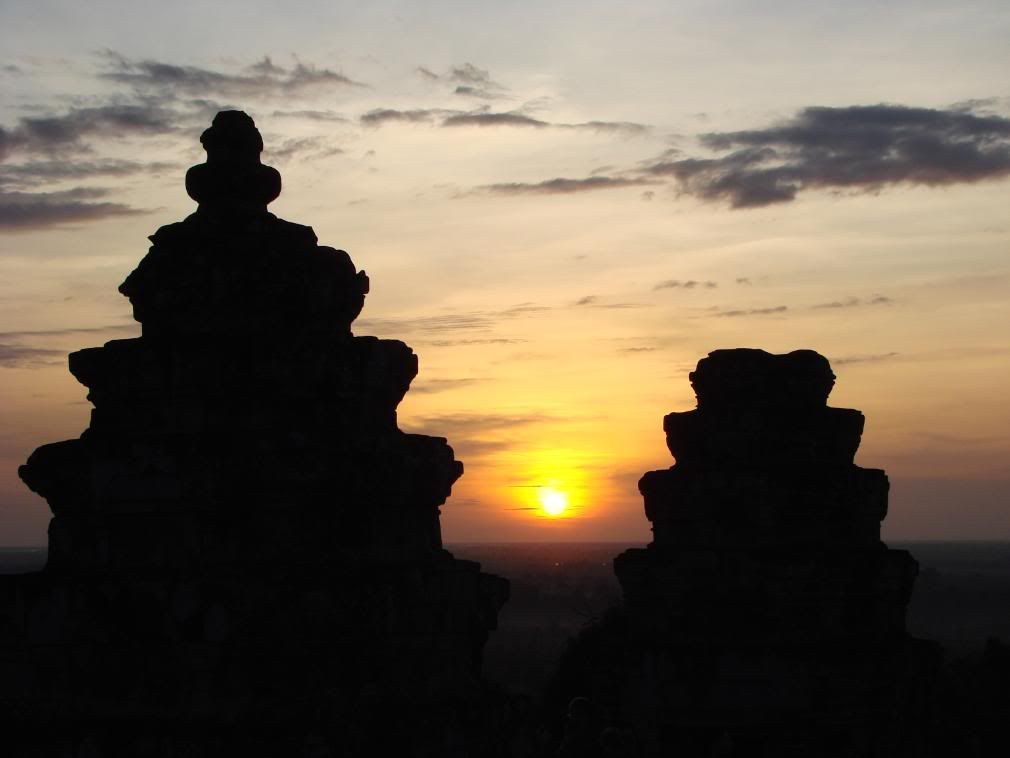 Although we had enjoyed our time in SE Asia, we were ready to move on and are very excited to be heading to our most anticipated destination, the subcontinent of India. (In actuality we have already left India but have had trouble finding high-speed internet to upload our pictures but India updates will be forthcoming very soon; yeah yeah we know you've heard that before).
Although we had enjoyed our time in SE Asia, we were ready to move on and are very excited to be heading to our most anticipated destination, the subcontinent of India. (In actuality we have already left India but have had trouble finding high-speed internet to upload our pictures but India updates will be forthcoming very soon; yeah yeah we know you've heard that before).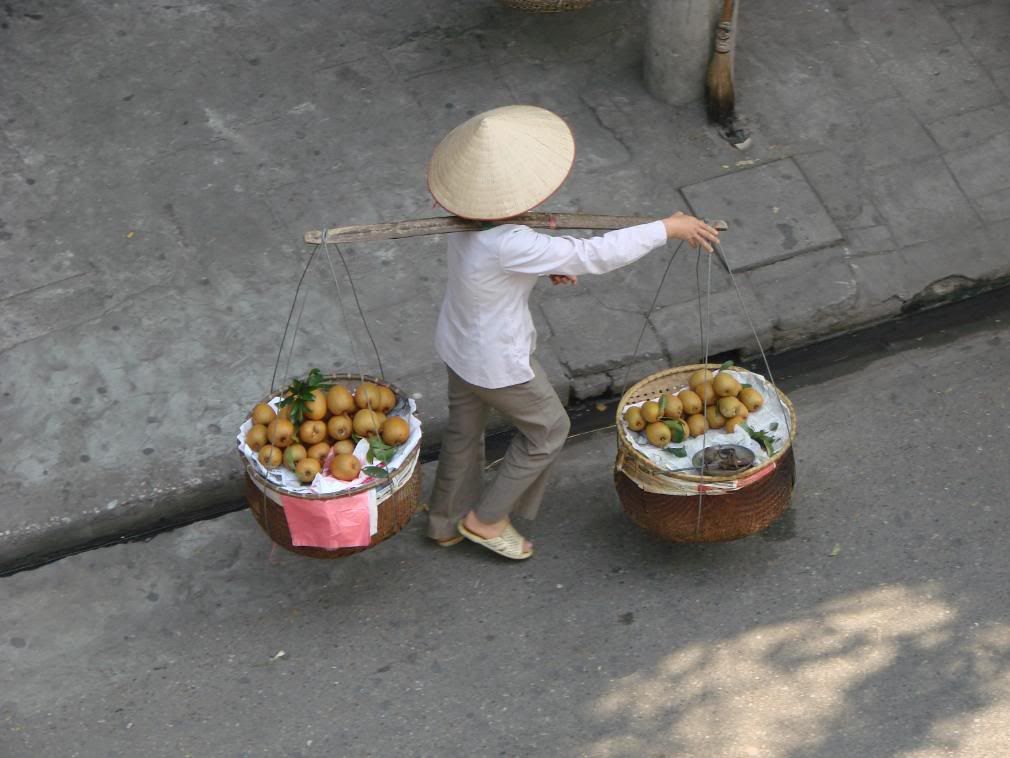
 We were pretty psyched to score a nice big room with A/C, king size bed, French décor, and a balcony for $8/night.
We were pretty psyched to score a nice big room with A/C, king size bed, French décor, and a balcony for $8/night.

















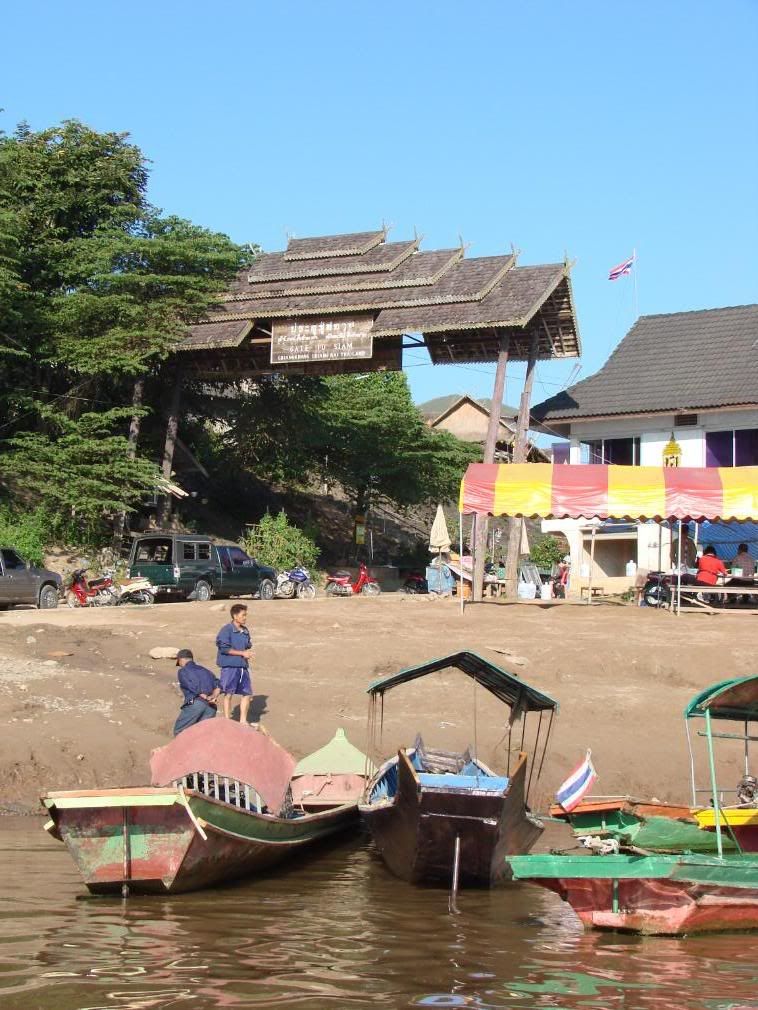 We’d been forewarned that traveling in Laos was time consuming so we expected complications but our connecting bus left just 10 minutes after arrival. (Concerning the slow pace, locals like to say that Laos PDR stands for “People Don’t Rush” rather than People’s Democratic Republic.) Packed in to a small van with eight other men we departed. One of the passengers carried on a canister which initially blasted our noses with the overwhelming odor of gasoline, despite the windows being down. Over time we unfortunately acclimated to this smell, and an even more disturbing stench began to materalize: a toxic combination of two-week old BO and rotting meat. Once the man with the gas can got dropped off, the air quickly became unbreathable. The driver grew very agitated and gave each of us piercing stares in the rearview mirror while we each looked around trying to pinpoint the malodorous culprit. After what seemed an eternity, the bus driver finally stopped the bus and threw the two passengers off who were sitting directly behind us, in the middle of nowhere. Breathing a collective sigh, we continued north through some beautiful rolling green mountains, stopping occasionally to peruse the the freshly slaughtered giant rabbits that were on display on the side of the road. It was a crazy ride to say the least.
We’d been forewarned that traveling in Laos was time consuming so we expected complications but our connecting bus left just 10 minutes after arrival. (Concerning the slow pace, locals like to say that Laos PDR stands for “People Don’t Rush” rather than People’s Democratic Republic.) Packed in to a small van with eight other men we departed. One of the passengers carried on a canister which initially blasted our noses with the overwhelming odor of gasoline, despite the windows being down. Over time we unfortunately acclimated to this smell, and an even more disturbing stench began to materalize: a toxic combination of two-week old BO and rotting meat. Once the man with the gas can got dropped off, the air quickly became unbreathable. The driver grew very agitated and gave each of us piercing stares in the rearview mirror while we each looked around trying to pinpoint the malodorous culprit. After what seemed an eternity, the bus driver finally stopped the bus and threw the two passengers off who were sitting directly behind us, in the middle of nowhere. Breathing a collective sigh, we continued north through some beautiful rolling green mountains, stopping occasionally to peruse the the freshly slaughtered giant rabbits that were on display on the side of the road. It was a crazy ride to say the least.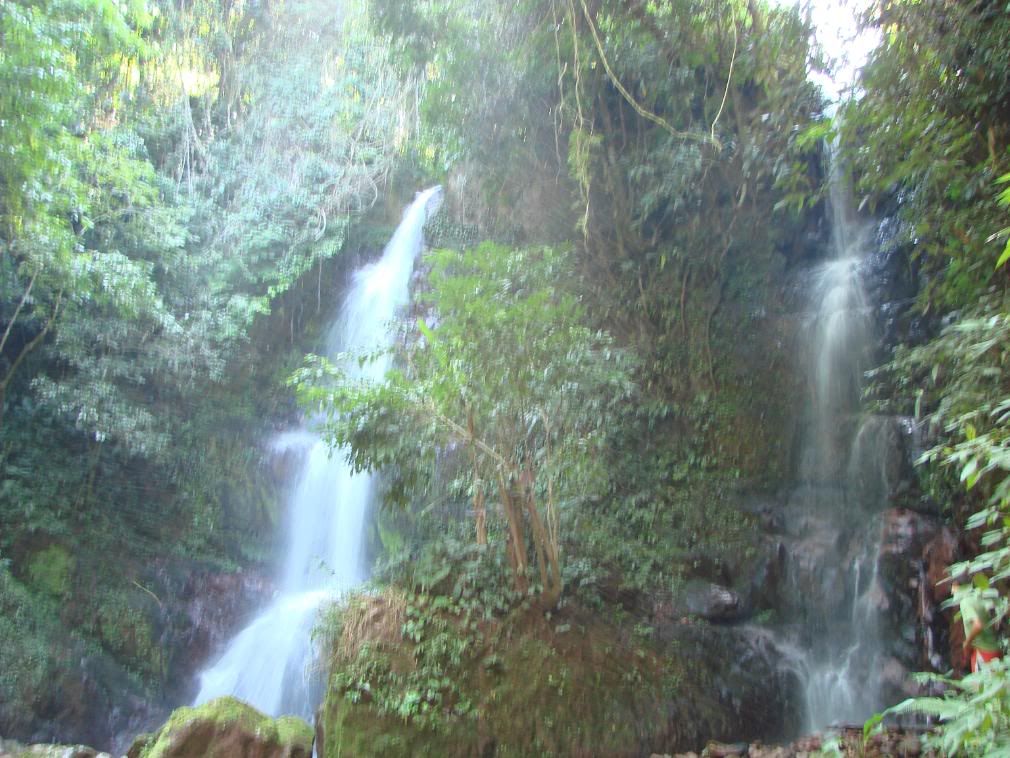 Along the way, our trekking guides chopped down some fresh sugar cane which we eagerly chewed. After a few hours, we arrived at a couple of beautiful waterfalls under which Jason and Gui had a frigid swim. There, we met up with some of the villagers in their colorful traditional garb, who cooked us lunch served on banana leafs. After lunch, we split into two groups: Jason, Gui, and the European couple were lured on an “adventure” to another waterfall that had never been visited by non-locals while Priti and the Israelis took a more relaxed path to the Ahka village where we were sleeping that night.
Along the way, our trekking guides chopped down some fresh sugar cane which we eagerly chewed. After a few hours, we arrived at a couple of beautiful waterfalls under which Jason and Gui had a frigid swim. There, we met up with some of the villagers in their colorful traditional garb, who cooked us lunch served on banana leafs. After lunch, we split into two groups: Jason, Gui, and the European couple were lured on an “adventure” to another waterfall that had never been visited by non-locals while Priti and the Israelis took a more relaxed path to the Ahka village where we were sleeping that night. 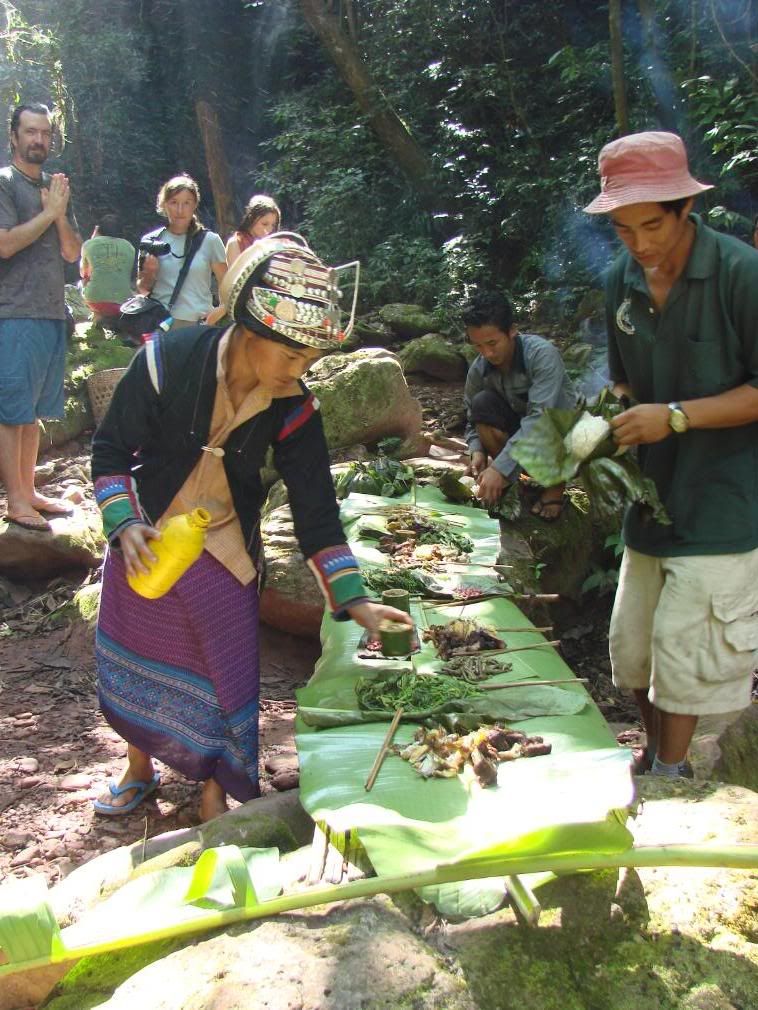 For Jason’s group, the adventure started immediately as they climbed nearly vertically adjacent to the waterfall before reaching a path after about 15 minutes. The trail eventually vanished and Jason found himself in the precarious situation of descending an incredibly steep mountain where there was no trail and nothing secure to prevent him falling to his death. Whereas the guides, who weighed about 60 kg (130 lbs) could step on the rocks, when Jason stepped on them they slid down the mountain. Even the decayed trees would snap when he grabbed hold. There was about a half-hour time span where he feared each step might be his last. After each of us fell about a half-dozen times (except for Gui, who was younger and more agile), the guides began to dig divets with their knives to give us a modicum of footing. At the bottom of the mountain, by which time Jason had cut open a finger and scraped up his legs, was a river that the guides mistakenly thought would serve as a sufficient trail.
For Jason’s group, the adventure started immediately as they climbed nearly vertically adjacent to the waterfall before reaching a path after about 15 minutes. The trail eventually vanished and Jason found himself in the precarious situation of descending an incredibly steep mountain where there was no trail and nothing secure to prevent him falling to his death. Whereas the guides, who weighed about 60 kg (130 lbs) could step on the rocks, when Jason stepped on them they slid down the mountain. Even the decayed trees would snap when he grabbed hold. There was about a half-hour time span where he feared each step might be his last. After each of us fell about a half-dozen times (except for Gui, who was younger and more agile), the guides began to dig divets with their knives to give us a modicum of footing. At the bottom of the mountain, by which time Jason had cut open a finger and scraped up his legs, was a river that the guides mistakenly thought would serve as a sufficient trail. 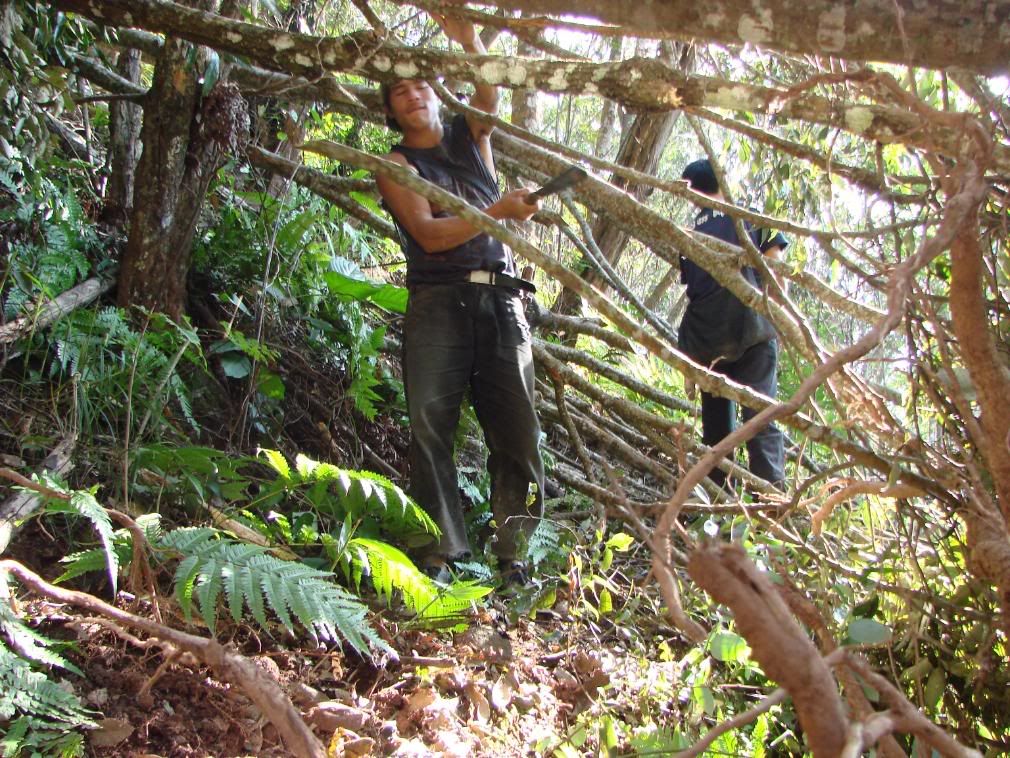 After slipping several times on the wet rocks and soaking our shoes we all were getting increasingly frustrated with our “adventure.” The guides themselves seemed unsure about how to proceed and eventually began arguing over whether to continue along the river or head back up another mountain. As the sky was quickly darkening, we decided the river was no longer feasible and demanded a change of course. As we ascended the mountain, it quickly became evident that we would not make it back before nightfall; rather, as the guides informed us, we were still at least three hours from the village! The three hours passed without much incident, although the Slovenian women lost her cool and started yelling at everyone after she fell yet again.
After slipping several times on the wet rocks and soaking our shoes we all were getting increasingly frustrated with our “adventure.” The guides themselves seemed unsure about how to proceed and eventually began arguing over whether to continue along the river or head back up another mountain. As the sky was quickly darkening, we decided the river was no longer feasible and demanded a change of course. As we ascended the mountain, it quickly became evident that we would not make it back before nightfall; rather, as the guides informed us, we were still at least three hours from the village! The three hours passed without much incident, although the Slovenian women lost her cool and started yelling at everyone after she fell yet again.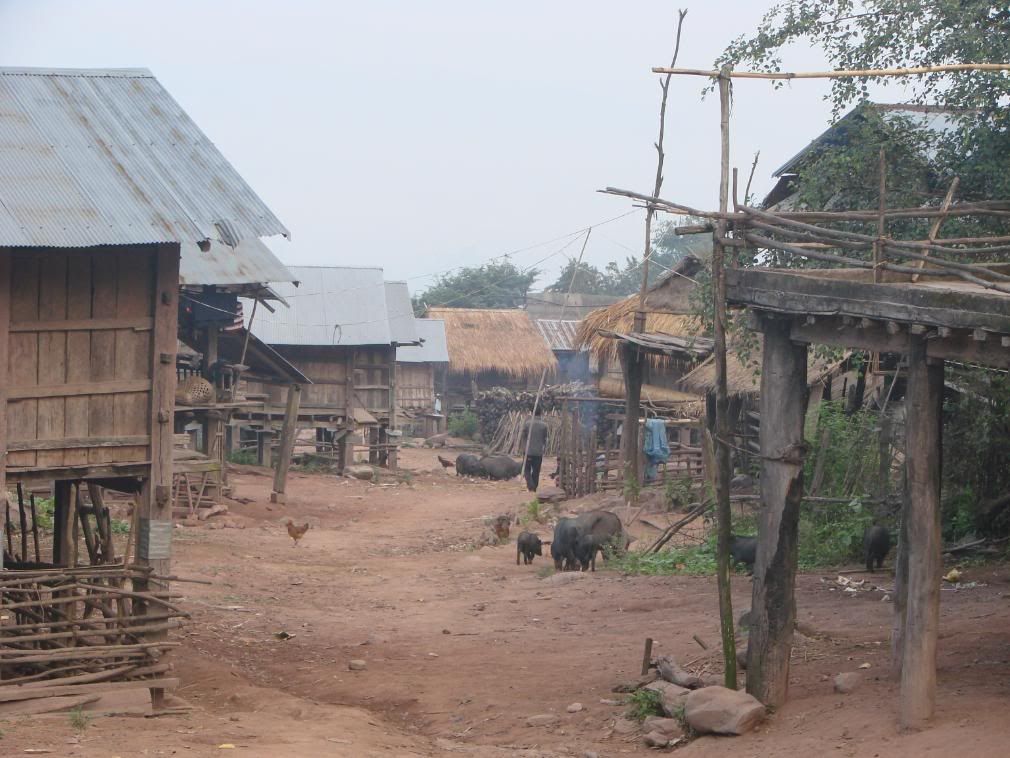 The exceptions were a whimpering duck and chicken that a young boy carried by the necks. The Israeli girls were freaking out because the animals were being “tortured” and it wasn’t kosher. Priti watched as the animals were slaughtered and had their feathers removed. After the duck’s feathers were removed, a male villager plunged it into almost boiling water and then proceeded to remove more fine feathers. He then took the dead animals and roasted their skin by holding the duck feet above the fire and then removing the webbing of the feet. As the darkness descended, she began to worry about Jason’s group, fearing that perhaps someone had sustained an injury without any way to contact others for help.
The exceptions were a whimpering duck and chicken that a young boy carried by the necks. The Israeli girls were freaking out because the animals were being “tortured” and it wasn’t kosher. Priti watched as the animals were slaughtered and had their feathers removed. After the duck’s feathers were removed, a male villager plunged it into almost boiling water and then proceeded to remove more fine feathers. He then took the dead animals and roasted their skin by holding the duck feet above the fire and then removing the webbing of the feet. As the darkness descended, she began to worry about Jason’s group, fearing that perhaps someone had sustained an injury without any way to contact others for help.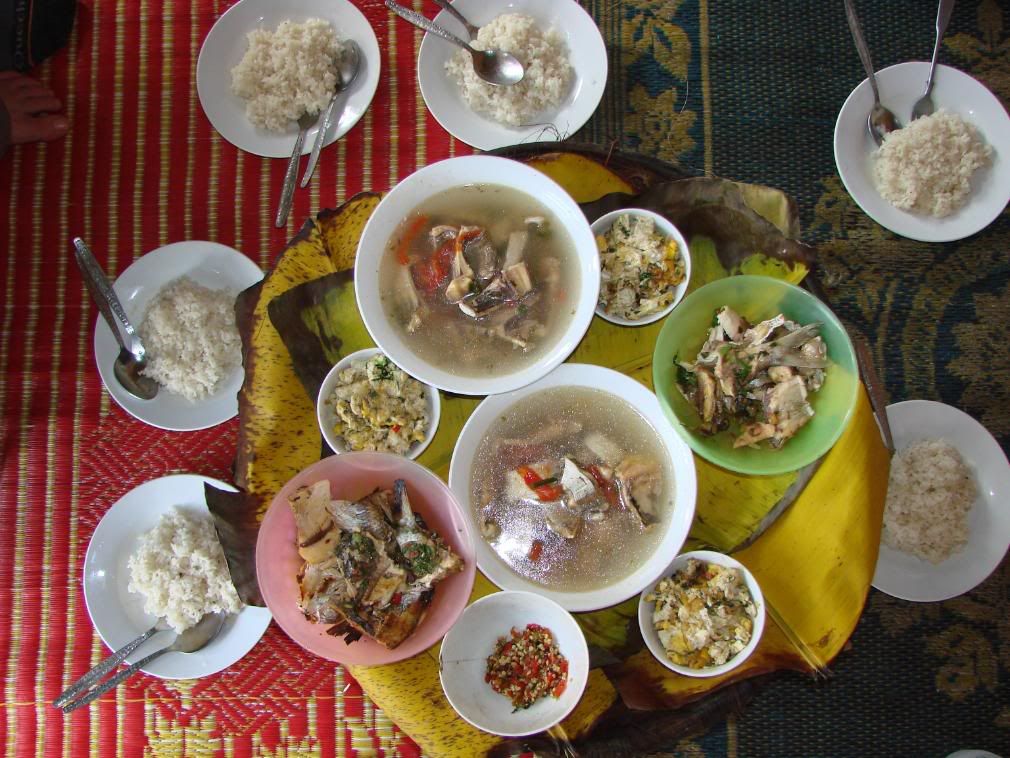 Jason’s annoyance from the hike did not dissipate after being exposed to a scalding hot shower and adding burns to his menagerie of minor injuries. Thankfully, the dinner the Akha villagers prepared for us was spectacular—ten different dishes including the fresh chicken and duck mixed together, cabbage soup, mixed veggies dish, and an incredible pumpkin curry. The villagers were with us the entire time, enjoying the meal and not hassling us. After our superb meal, everyone (except Priti due to her lingering esophageal pain) drank Lao-Lao which is the local rice liquor, brewed in the village.
Jason’s annoyance from the hike did not dissipate after being exposed to a scalding hot shower and adding burns to his menagerie of minor injuries. Thankfully, the dinner the Akha villagers prepared for us was spectacular—ten different dishes including the fresh chicken and duck mixed together, cabbage soup, mixed veggies dish, and an incredible pumpkin curry. The villagers were with us the entire time, enjoying the meal and not hassling us. After our superb meal, everyone (except Priti due to her lingering esophageal pain) drank Lao-Lao which is the local rice liquor, brewed in the village. 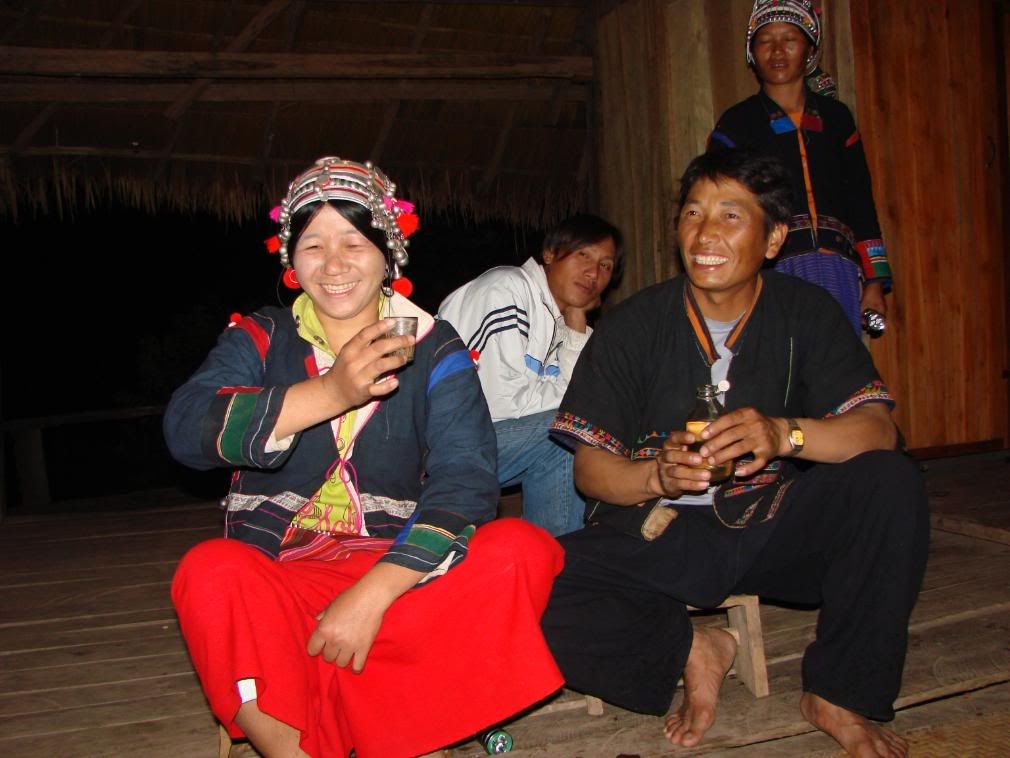 This was followed by the villagers sitting around a fire inside the hut and singing some folk songs. Our evening concluded with an interesting massage from the villagers which included having our toes individually pulled until they popped, causing each of us to laugh and yelp in pain.
This was followed by the villagers sitting around a fire inside the hut and singing some folk songs. Our evening concluded with an interesting massage from the villagers which included having our toes individually pulled until they popped, causing each of us to laugh and yelp in pain. As we visited each one, we commented on how we felt like we were the ones being observed as much as observing and how it was as if we were in a National Geographic special. The villages were all stilt houses made of bamboo and wood with thatched roofs made of banana leaves. One of them had just received electricity, as evidenced by its brand new watt hour meter reading of two. Oblivious to our presence, some of the women walked around bare-chested while others breastfed, a stark contrast to western culture, which shamefully treats breastfeeding as if it’s a taboo. Kids were running around sans clothing as well, playing a form of bowling with tattered sandals and rusted aluminum cans. People were comfortable being themselves; a wonderful environment that we felt extremely privileged to witness. We ventured onward to another village where they tried teaching us how to spin cotton and Priti enjoyed the effort despite her failure to keep the thread in tact.
As we visited each one, we commented on how we felt like we were the ones being observed as much as observing and how it was as if we were in a National Geographic special. The villages were all stilt houses made of bamboo and wood with thatched roofs made of banana leaves. One of them had just received electricity, as evidenced by its brand new watt hour meter reading of two. Oblivious to our presence, some of the women walked around bare-chested while others breastfed, a stark contrast to western culture, which shamefully treats breastfeeding as if it’s a taboo. Kids were running around sans clothing as well, playing a form of bowling with tattered sandals and rusted aluminum cans. People were comfortable being themselves; a wonderful environment that we felt extremely privileged to witness. We ventured onward to another village where they tried teaching us how to spin cotton and Priti enjoyed the effort despite her failure to keep the thread in tact. 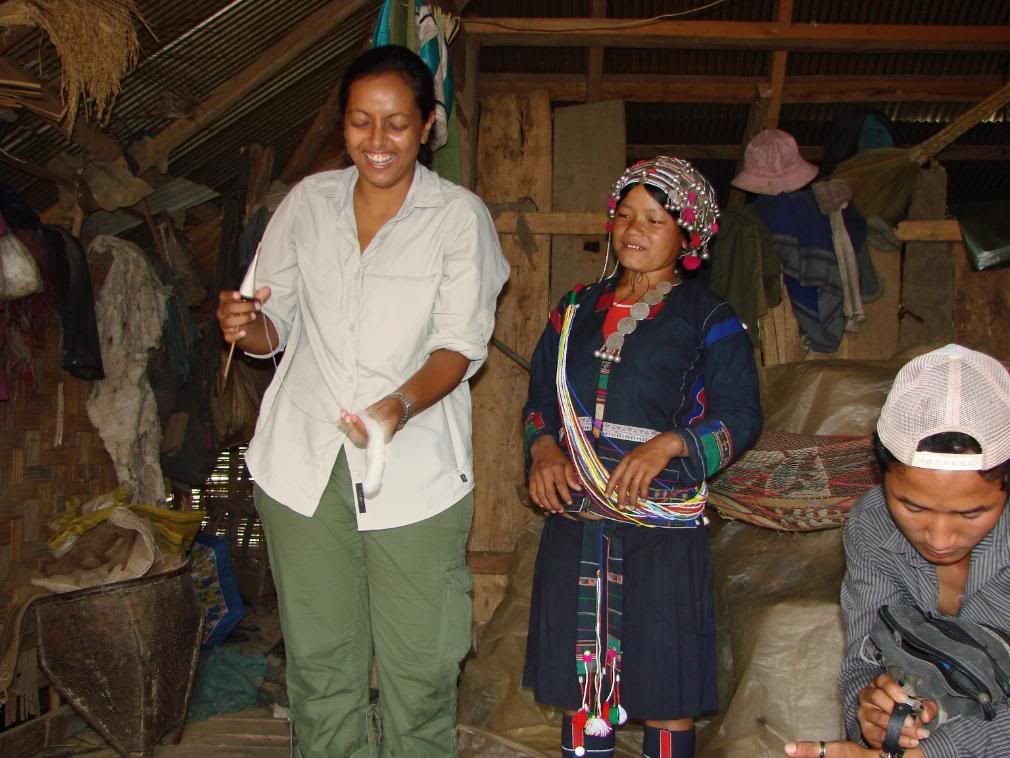 After their demonstration, the village people gave us a gift of handmade, woven pouches. It was awesome. Some of the boys showed off their slingshot skills while Jason chased several of the girls, who ran away laughing and screaming (save for one who was mute). We were then shown that village’s "bachelor" room, which is a tiny room attached to the family’s home in which their young son can practice having sex with other women.
After their demonstration, the village people gave us a gift of handmade, woven pouches. It was awesome. Some of the boys showed off their slingshot skills while Jason chased several of the girls, who ran away laughing and screaming (save for one who was mute). We were then shown that village’s "bachelor" room, which is a tiny room attached to the family’s home in which their young son can practice having sex with other women. 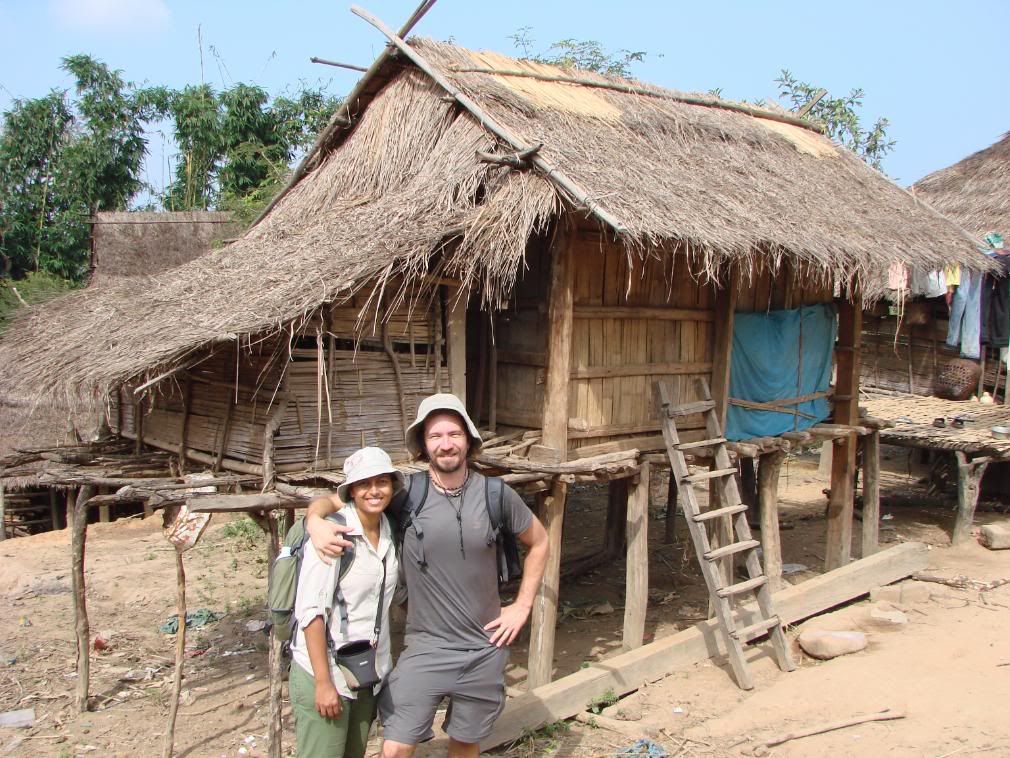 There’s also such a thing as a youth leader who, if a boy is interested, can ask a girl to spend the night with him, even if she already has a boyfriend. The girl cannot refuse and if she becomes pregnant, another older man in the village marries her or shy gets kicked out of the village! Despite our revulsion with such oppressive traditions and Jason’s near-death experience, we thoroughly enjoyed the Akha experience.
There’s also such a thing as a youth leader who, if a boy is interested, can ask a girl to spend the night with him, even if she already has a boyfriend. The girl cannot refuse and if she becomes pregnant, another older man in the village marries her or shy gets kicked out of the village! Despite our revulsion with such oppressive traditions and Jason’s near-death experience, we thoroughly enjoyed the Akha experience.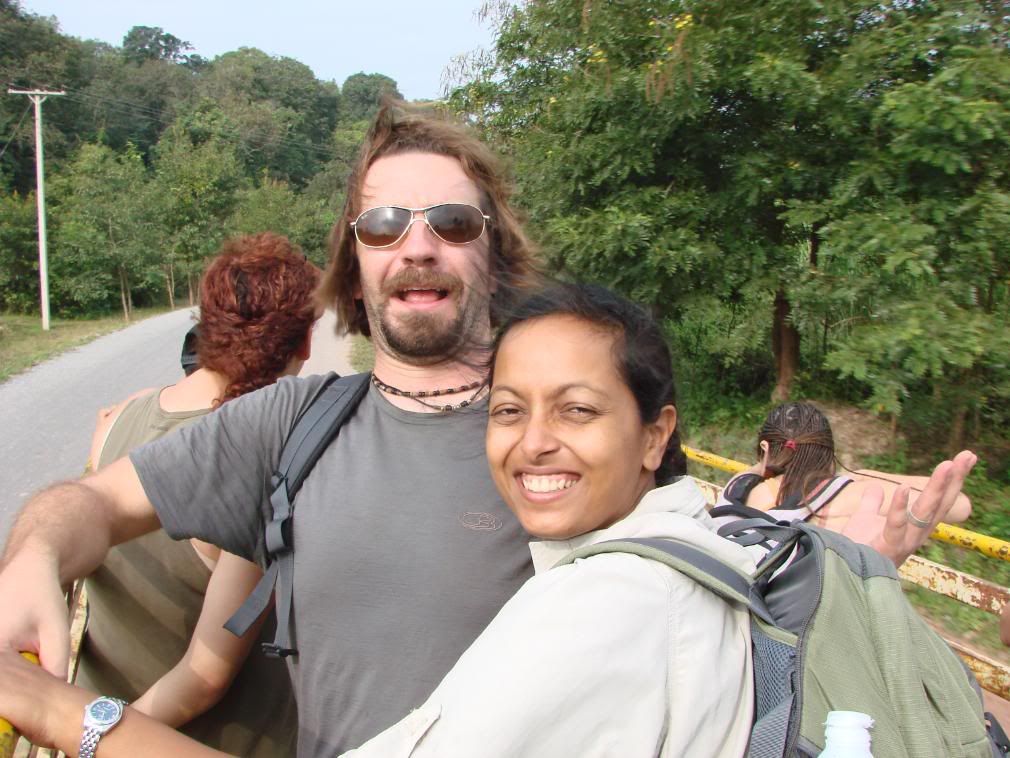 The locals quizzically stared as we drove by. Thankfully, we didn’t miss our bus and made it back to Luang Nam Tha. That evening, we went to some type of carnival, where vendors sold all types of food and the children played a game that involved throwing darts at a board filled with balloons; three hits resulted in a prize. Jason, despite being a regular darts player, was unable to win after repeated attempts. The evening was also significant because it was our first taste of BeerLao, which is one of the best beers on earth and costs about $1 for a big bottle (i.e., 2 beers).
The locals quizzically stared as we drove by. Thankfully, we didn’t miss our bus and made it back to Luang Nam Tha. That evening, we went to some type of carnival, where vendors sold all types of food and the children played a game that involved throwing darts at a board filled with balloons; three hits resulted in a prize. Jason, despite being a regular darts player, was unable to win after repeated attempts. The evening was also significant because it was our first taste of BeerLao, which is one of the best beers on earth and costs about $1 for a big bottle (i.e., 2 beers). We turned around expecting to see the motorist on the ground, but apparently there was another cause as the motorcyclist kept going. The mystery remained unsolved after a half hour of sitting there trying to figure out what had happened. About an hour later, the bus suffered a flat tire, which is virtually inevitable on this route due to the condition and windiness of the road. After we arrived in Luang Prabang, Jason discovered that his water bottle and sunglasses (his 6th pair thus far on the trip!) had been swiped by another passenger.
We turned around expecting to see the motorist on the ground, but apparently there was another cause as the motorcyclist kept going. The mystery remained unsolved after a half hour of sitting there trying to figure out what had happened. About an hour later, the bus suffered a flat tire, which is virtually inevitable on this route due to the condition and windiness of the road. After we arrived in Luang Prabang, Jason discovered that his water bottle and sunglasses (his 6th pair thus far on the trip!) had been swiped by another passenger.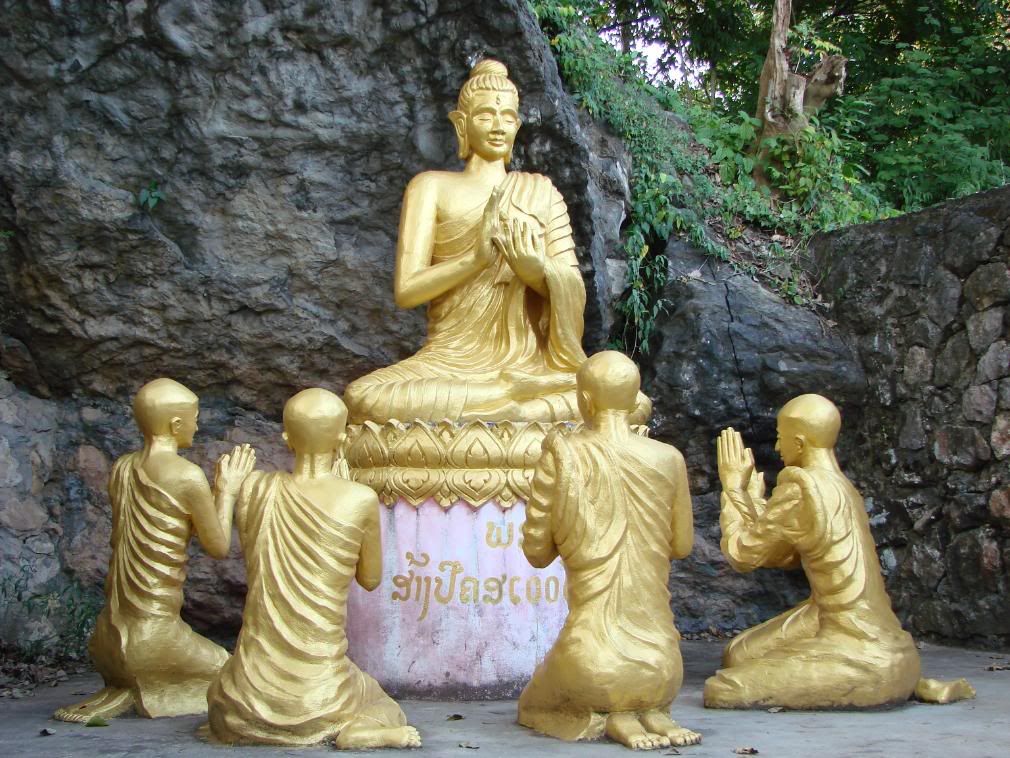 There is a huge hill in the middle, with a series of Buddhist Wats atop it, as well as inside a series of caves within the hill, one of which apparently contained a footprint of Buddha. The top of the hill is also a popular sunset spot, according to LP (the guidebook). Granted, it was a nice view with the sun setting over a mountaintop, but it was also a zoo up there, with tourists of all nationalities jostling for the best spot and some openly shoving others in their zeal to get the perfect picture. Jason was nearly knocked over a ledge by a European with a camera lens bigger than his concern for others' safety. Later that night, we ran into Carol, a Californian we’d hung out with in Pai. She seemed a bit out of it and recounted her horrific journey on the overnight bus from Pai.
There is a huge hill in the middle, with a series of Buddhist Wats atop it, as well as inside a series of caves within the hill, one of which apparently contained a footprint of Buddha. The top of the hill is also a popular sunset spot, according to LP (the guidebook). Granted, it was a nice view with the sun setting over a mountaintop, but it was also a zoo up there, with tourists of all nationalities jostling for the best spot and some openly shoving others in their zeal to get the perfect picture. Jason was nearly knocked over a ledge by a European with a camera lens bigger than his concern for others' safety. Later that night, we ran into Carol, a Californian we’d hung out with in Pai. She seemed a bit out of it and recounted her horrific journey on the overnight bus from Pai. 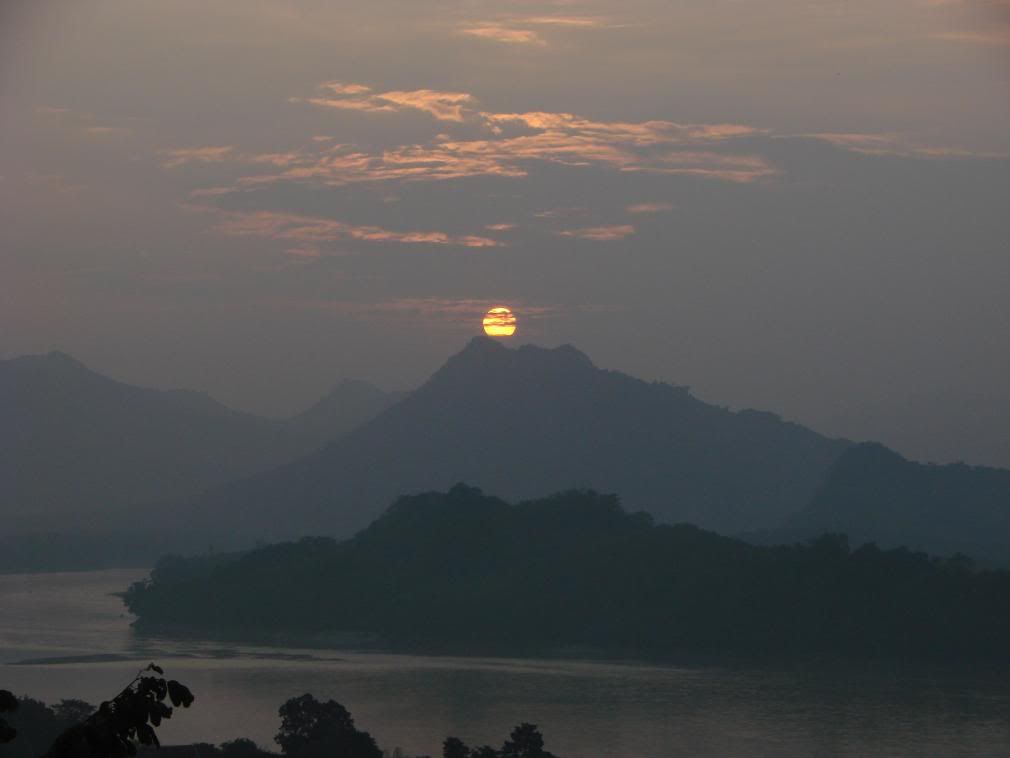 The driver, intoxicated, had crashed their bus into a tree at about 4 am. Most of the eight passengers sustained concussions and one suffered a broken arm. The driver suffered the worst, as he broke all four of his limbs and fractured his skull. His survival seemed dubious. As Carol was relating her traumatic story, a tuk-tuk drove by filled with drunken men singing Ole Ole and hanging out of the vehicle. “Oh, those were the guys on the bus with us, they’ve lost their minds,” she said, before excusing herself to get some rest. Priti, mindful of our guesthouse’s 11 pm curfew, also retired for the evening, but Jason sensed adventure so he wandered off in the direction of the tuk-tuk. After a brief visit to one of the three bars in town, he learned that the only late-night spot was a bowling alley outside of the city limits.
The driver, intoxicated, had crashed their bus into a tree at about 4 am. Most of the eight passengers sustained concussions and one suffered a broken arm. The driver suffered the worst, as he broke all four of his limbs and fractured his skull. His survival seemed dubious. As Carol was relating her traumatic story, a tuk-tuk drove by filled with drunken men singing Ole Ole and hanging out of the vehicle. “Oh, those were the guys on the bus with us, they’ve lost their minds,” she said, before excusing herself to get some rest. Priti, mindful of our guesthouse’s 11 pm curfew, also retired for the evening, but Jason sensed adventure so he wandered off in the direction of the tuk-tuk. After a brief visit to one of the three bars in town, he learned that the only late-night spot was a bowling alley outside of the city limits.  When he arrived, he witnessed pure mayhem as seemingly every table had a half-empty bottle of whiskey on it and the noise-level prevented the formation of all but the most basic thoughts. Jason spotted several of the folks from Pai and joined them in a chaotic game of bowling. Incidentally, he bowled one of his best games ever, including a turkey (i.e., three strikes in a row). It was one of the Irish guys’ birthdays and so they decided, in their post-concussive and inebriated states, that they needed to do something crazy. Before Jason knew what was happening, two of them ran down the lanes and sprawled themselves out, completely naked! Laotians are a modest people, and they love their bowling, so the Irishman’s antics were about the most offensive thing they could have done. The manager quickly hauled them off and called in a higher authority, who seemed to be like the mayor of the town. Upon hearing their transgressions, he immediately banished them from not just the city, but from the country!
When he arrived, he witnessed pure mayhem as seemingly every table had a half-empty bottle of whiskey on it and the noise-level prevented the formation of all but the most basic thoughts. Jason spotted several of the folks from Pai and joined them in a chaotic game of bowling. Incidentally, he bowled one of his best games ever, including a turkey (i.e., three strikes in a row). It was one of the Irish guys’ birthdays and so they decided, in their post-concussive and inebriated states, that they needed to do something crazy. Before Jason knew what was happening, two of them ran down the lanes and sprawled themselves out, completely naked! Laotians are a modest people, and they love their bowling, so the Irishman’s antics were about the most offensive thing they could have done. The manager quickly hauled them off and called in a higher authority, who seemed to be like the mayor of the town. Upon hearing their transgressions, he immediately banished them from not just the city, but from the country! 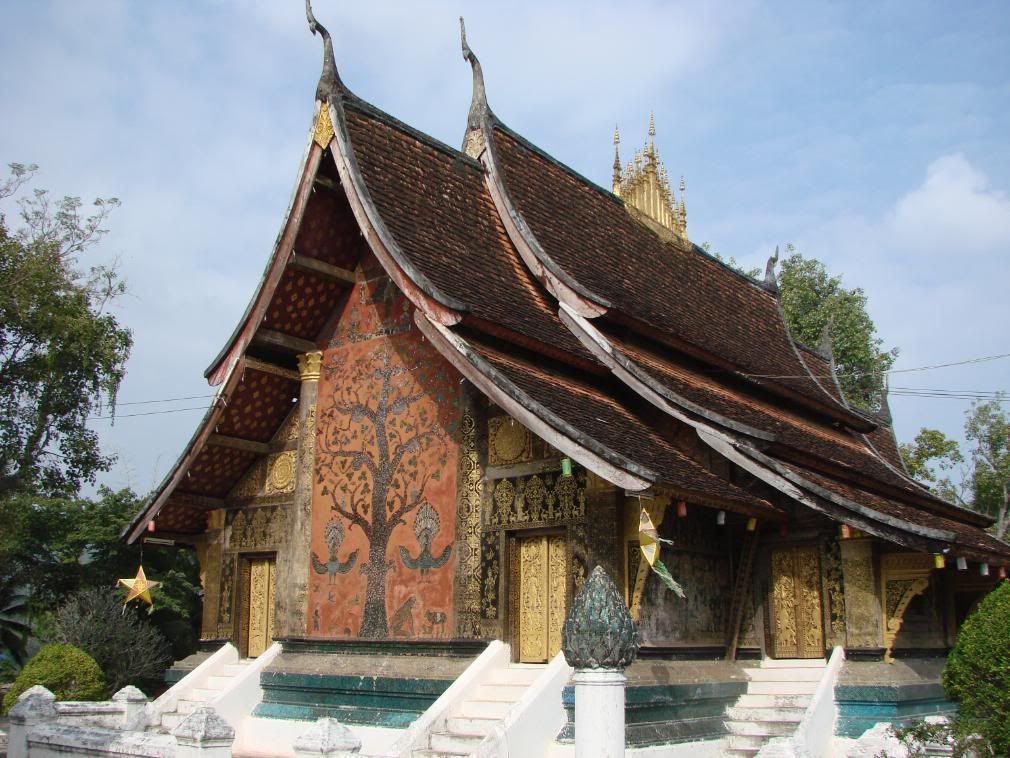 Some uniformed men arrived shortly thereafter and took them away while the rest of us looked at each other in disbelief. Upon returning to the guesthouse, it was locked, but fortunately Jason was able to wake up one of the workers to let him. Others were not so lucky and were unable to get into their rooms until 6 am the following morning.
Some uniformed men arrived shortly thereafter and took them away while the rest of us looked at each other in disbelief. Upon returning to the guesthouse, it was locked, but fortunately Jason was able to wake up one of the workers to let him. Others were not so lucky and were unable to get into their rooms until 6 am the following morning.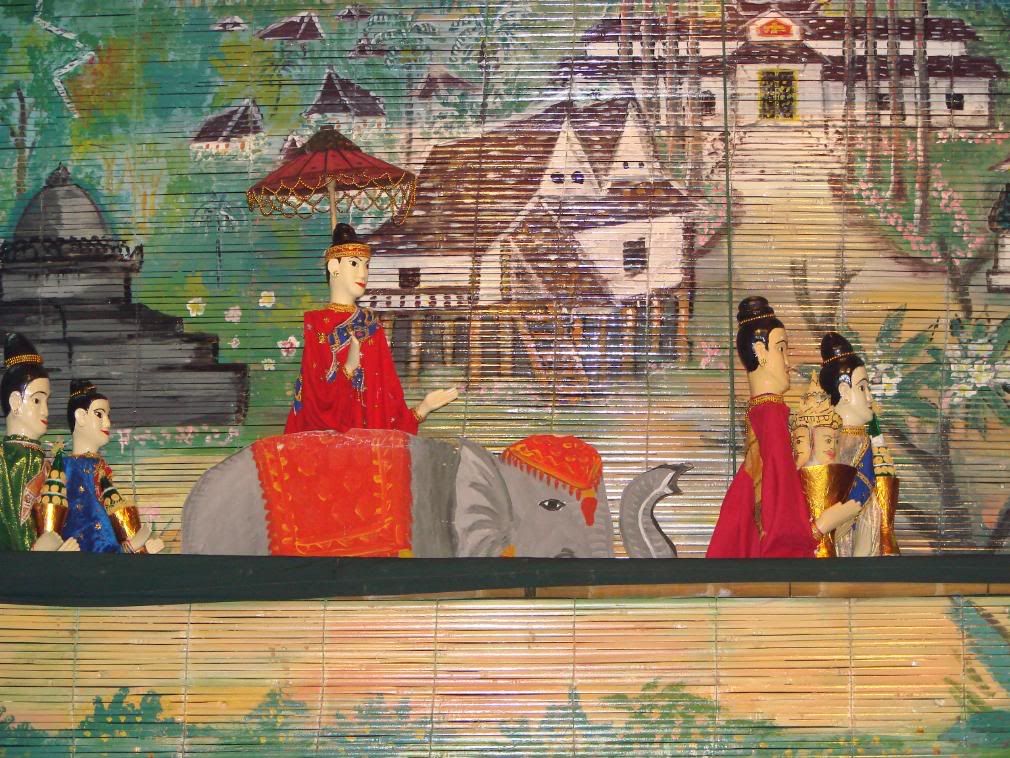 Nonetheless, given the brevity of our visit, we stuck with the local food and were rewarded with some excellent coconut curry steamed fish in a banana leaf and kai-pan, a local specialty which consisted of fried seaweed and a chili paste to dip it in. Jason loved it so much that he ordered it with every subsequent meal and even got some of the chili paste for the road. That evening we were entertained by a cultural event put on by a local children's group, that included a series of dances and puppet shows.
Nonetheless, given the brevity of our visit, we stuck with the local food and were rewarded with some excellent coconut curry steamed fish in a banana leaf and kai-pan, a local specialty which consisted of fried seaweed and a chili paste to dip it in. Jason loved it so much that he ordered it with every subsequent meal and even got some of the chili paste for the road. That evening we were entertained by a cultural event put on by a local children's group, that included a series of dances and puppet shows.